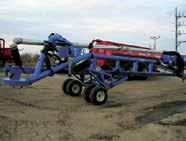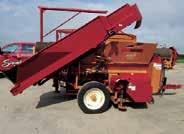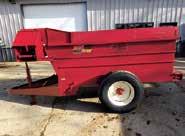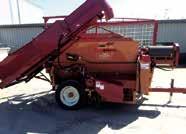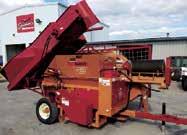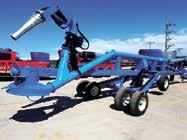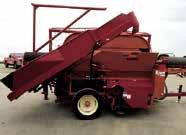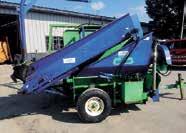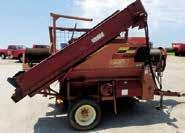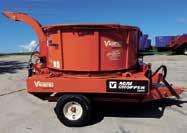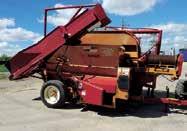DAIRY ST R
Volume 24, No. 19


Volume 24, No. 19

CUBA CITY, Wis. –
Tim Vosberg was working a white-collar job in the Chicago suburbs when he was in his 20s. Employed by a dairy equipment manufacturer, he was sent around the country to troubleshoot issues on large dairy farms.
When his youngest brother died in 1997 and his dad needed help running the farm in Grant County, Vosberg traded his suit and tie for a life of dairy farming.
“When tragedy happens to your family, you really evaluate what’s important,” Vosberg said. “Climbing the corporate ladder didn’t seem
like it was all that important anymore.”
When Vosberg entered the world of dairy farming once more, he forged his path on a farm of his own while his brother, Mark, took over their father’s farm.
Today, Vosberg milks 120 cows on an organic farm with the help of his wife, Heidi, and their six children, Gwen, Wesley, Tabitha, Calista, Serena and Rachel.
Wesley’s girlfriend, Cailyn Lord, is also involved in the operation, and Vosberg’s nephew, Tyler, helps full time on the farm. The family farms 380 acres and has 70 acres in pasture.
Vosberg said he plans to transition the responsibilities of the farm to the next generation over the next 10 years and explore a different career path in his 60s.



“I want to transfer all

the responsibility to the next generation early,” Vosberg said. “I personally would
love to be one that transitions to something else and not be in charge until I’m 85

BRILLION, Wis. –
Three years ago, Brandon and Shianne Ferry and Brandon’s dad, Tim, decided to combine their milking herds. The arrangement gave way to needing less labor and providing the younger Ferry with a more consistent source of feed. Both generations were spread thin, and instead of continuing to farm separately, they pooled their resources and created a win-win situation for both father and son.

“My dad was looking for a way to cut down on labor, and I was looking for an easier way to nd feed,” Brandon said. “I had a hard time nding quality feed. But here, we have a consistent source, and that’s a big thing. Also, my wife and I
November 26, 2022
STACEY SMART/DAIRY STARThe Ferry family – Shianne (from le�), Brandon and Tim – milk 300 cows near Brillion, Wisconsin. The Ferrys combined herds at a rented facility in 2019 to help reduce labor and provide more consistent feed.
had two kids at the time and wanted to make it easier to farm while raising a family.”
Now, Brandon and his father share the work on the farm they rent near Brillion where they milk 300
cows. Their milking herds converged at a neutral location between their two farms when Brandon’s herd of 80 cows joined his dad’s herd of 220 in 2019. Tim has been milking at this location for 12 years
after moving his herd from Pickett, where Brandon grew up. Cows are milked twice a day in a double-8 herringbone parlor and housed in a 240-stall freestall barn. Tim and Brandon rent the buildings while another farmer rents the land.
“That farmer puts up the feed for us, and we purchase it from him,” Brandon said.
Brandon used to feed his cows corn silage, baled hay and top-dressed grain. Now, his cows receive a total mixed ration consisting of corn silage, haylage, and a corn and protein mix.
Brandon’s farm is about 5 miles away near Hilbert, and Tim’s farm is about 1 mile from the farm they rent. Youngstock remain at each of their respective farms. Tim also houses all of the dry cows and springing heifers, and all animals calve at his farm.
years old. I can still support
Dairy is in 96% of U.S. households using up 80% of what the United States produces. The rest is exported. That is where the United States Dairy Export Council comes in.
Krysta Harden is the U.S. Dairy Exports Council president and CEO.
“If you look at exports, there is no way that you can’t be excited about what’s coming,” Harden said. “Somebody is going to meet the demand. I think it should be the U.S.”
Consumers are becoming more aware of how dairy can be used, and marketing,
Ferrys combine herds for greater efciency
www.dairystar.com
ISSN Print: 2834-619X • Online: 2834-6203
522 Sinclair Lewis Ave. Sauk Centre, MN 56378
Phone: 320-352-6303 Fax: 320-352-5647
Published by Star Publications LLC
General Manager/Editor
Mark Klaphake - mark.k@dairystar.com 320-352-6303 (ofce) 320-248-3196 (cell) 320-352-0062 (home)
Ad Composition - 320-352-6303
Nancy Powell • nancy.p@dairystar.com
AgDairy marketing specialist Robin Schmahl expects Class III milk prices to remain steady with little change expected in milk production or consumer demand. “Higher demand probably isn’t going to happen because of the current economic situation, and it will take a while before milk production declines,” Schmahl said. “Dairy producers need to take a hard look at this market and when there are opportunities to protect prices, do some marketing or sign up for (Dairy Margin Coverage); they need to embrace those things.”
was extending the status quo timeline to match another union. If either of the two largest unions are still voting, the deadline could be extended again. The Class I railroads reportedly planned to start shutting down service in anticipation of a work stoppage. The unions claimed the railroads are trying to cause panic and manipulate Congress to intervene.
Karen Knoblach
• karen.k@star-pub.com Annika Gunderson • annika@star-pub.com
Tiffany Klaphake - Assistant Editor 320-352-6303
• tiffany.k@dairystar.com
Maria Bichler - Assistant Editor maria.b@dairystar.com • 320-352-6303
Danielle Nauman - Staff Writer 608-487-1101
• danielle.n@dairystar.com
Stacey Smart - Staff Writer 262-442-6666
• stacey.s@dairystar.com
Abby Wiedmeyer - Staff Writer 608-487-4812
• abby.w@dairystar.com
Grace Jeurissen - Staff Writer 320-352-6303
• grace.j@star-pub.com
Jan Lefebvre - Staff Writer 320-290-5980

• jan.l@star-pub.com
Taylor Jerde - Staff Writer 507-403-1680 • taylor.j@star-pub.com

Consultant
Jerry Jennissen 320-346-2292
Main Ofce: 320-352-6303 Fax: 320-352-5647
Deadline is 5 p.m. of the Friday the week before publication Sales Manager - Joyce Frericks 320-352-6303 • joyce@dairystar.com
Mark Klaphake (Western MN) 320-352-6303 (ofce) 320-248-3196 (cell)
Laura Seljan (National Advertising, SE MN) 507-250-2217 • fax: 507-634-4413 laura.s@dairystar.com
Jerry Nelson (SW MN, NW Iowa, South Dakota) 605-690-6260 • jerry.n@dairystar.com
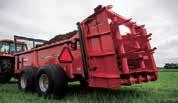

Mike Schafer (Central, South Central MN) 320-894-7825 • mike.s@dairystar.com
Amanda Hoeer (Eastern Iowa, Southwest Wisconsin) 320-250-2884 • amanda.h@dairystar.com
Megan Stuessel (Western Wisconsin) 608-387-1202 • megan.s@dairystar.com
Kati Kindschuh (Northeast WI and Upper MI) 920-979-5284 • kati.k@dairystar.com
Julia Mullenbach (Southeast MN and Northeast IA) 507-438-7739 • julia.m@star-pub.com
Bob Leukam (Northern MN, East Central MN) 320-260-1248 (cell) bob.l@star-pub.com
The deadline for news and advertising in the Dairy Star is 5 p.m. Friday the week before publication.
One year subscription $40.00, outside the U.S. $200.00. Send check along with mailing address to Dairy Star, 522 Sinclair Lewis Ave., Sauk Centre, MN 56378.

Our ad takers have no authority to bind this newspaper and only publication of an advertisement shall constitute nal acceptance of the advertiser's order.
Letters
Letters and articles of opinion are welcomed. Letters must be signed and include address and phone number. We reserve the right to edit lengthy letters. The views and opinions expressed by Dairy Star columnists and writers are not necessarily those of the Dairy Star / Star Publications LLC.

The Dairy Star is published semi-monthly by Star Publications LLC, 522 Sinclair Lewis Ave., Sauk Centre, MN 56378-1246. Periodicals Postage Paid at Sauk Centre, MN and additional mailing ofces.
POSTMASTER: Send address changes to Dairy Star, 522 Sinclair Lewis Ave., Sauk Centre, MN 56378-1246.

During a time of high commodity prices, rising land values and government payments, a percentage of farmers became complacent. Virginia Tech professor emeritus David Kohl made that point during the National Bankers Conference in Omaha, Nebraska. “You’re going to have a certain set of customers that are going to burn through working capital, liquidity and their equity, but you’re going to have another set of customers that will put prots on the table, build liquidity, build equity and they’re going to grow,” Kohl said. In this time of extreme volatility, Kohl said commodity prices could drop quickly. That makes it more important for farmers to know their breakeven costs and manage risk. The geopolitical environment can make changes in an instant. “Whether it’s China, the United States or the Federal Reserve, they’ll ip the switch and when change happens, it will happen very, very quickly,” he said.
The threat of a railroad strike is now off the table until Dec. 4 at the earliest. The previous strike deadline was Nov. 20. One of the major unions announced it
A delegation led by U.S. Dairy Export Council President and CEO Krysta Harden and Dairy Management Inc.
 By Don Wick Columnist
By Don Wick Columnist

Chair Marilyn Hershey participated in the United Nations Climate Change Conference in Egypt. “We are proud of U.S. dairy producers’ progress and leadership thus far,” Harden said. “But, we know we can do more.” USDEC and DMI participated in forums on sustainable dairy production during the COP27 conference.
For the past two years, President Biden has been in the Oval Ofce and the Democrats had the majority in the House and Senate. Republicans took control of the House in the election. Public policy consultant and lob-








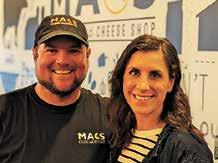










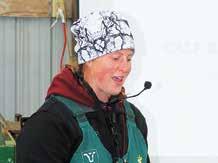
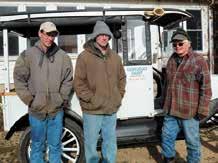




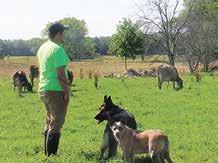






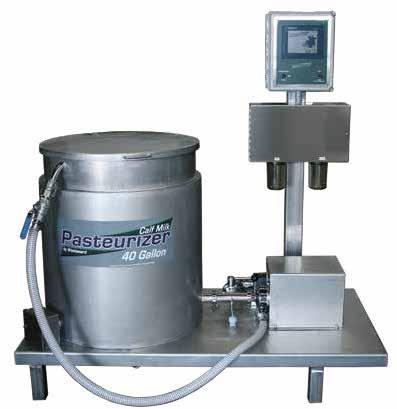
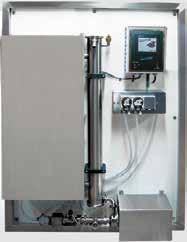

byist James Callan said this scenario will inuence the legislative agenda. “I think it will be difcult for the administration, if not impossible, to get anything major done.” If the Republicans win the majority in Congress, the chairmanship of the House Agriculture Committee would shift from current chairman David Scott of Georgia to G.T. Thompson of Pennsylvania. Callan believes Thompson would change the direction of the committee. “His priorities would be on dairy, forestry, nutrition from an oversight perspective and crop insurance,” Callan said. “Mr. Scott has focused on climate, racial equity and Southern commodities so I think there will be a signicant difference in their approach and priorities.” Thompson has already discussed an ambitious timeline for the farm bill, completing the legislation before its expiration at the end of September. Callan leads a public policy rm in Washington, D.C. and represents Midwestern farm groups.

Rep. Robin Vos, of Rochester, was reelected to serve as the speaker of the Wisconsin State Assembly for the 2023-24 legislative session. Vos is the longest serving speaker in state history. Rep. Kevin Petersen, of Waupaca, is speaker pro tempore and Rep. Tyler August, of Lake Geneva, is the majority leader.
Wisconsin will receive $7 million from U.S. Department of Agriculture’s Dairy Business Innovation Initiatives program. The funds will be used to increase milk processing capacity, making on-farm improvements and offering technical assistance. “As our dairy economy faces supply chain challenges, federal dollars will help Wisconsin dairy businesses to address those challenges,” Wisconsin Sen. Tammy Baldwin said.
Dairy farmers can enroll for 2023 Dairy Margin Coverage through Dec. 9. Last year, USDA took steps to improve coverage for small and mediumsized dairy farms. That includes the new Supplemental DMC program and an update to the feed cost formula.




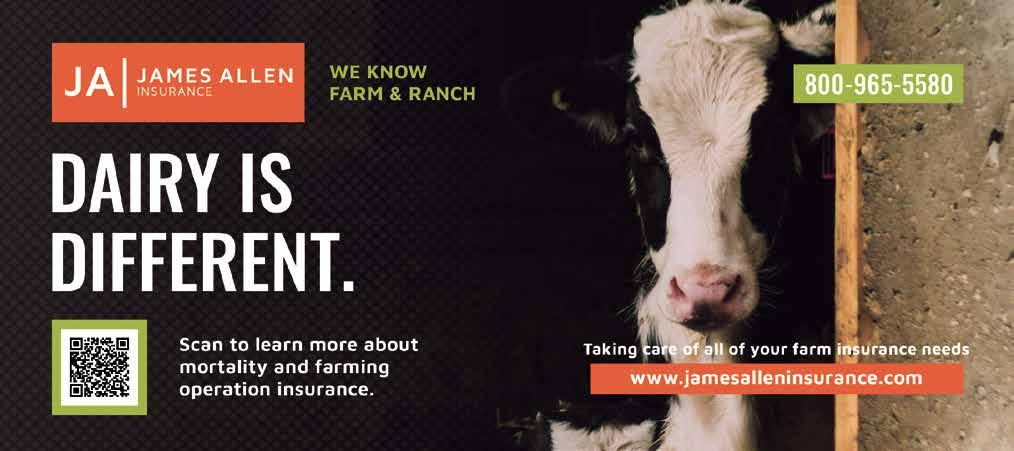





UW-Oshkosh biogas project praised

In his report to the Board of Regents, University of Wisconsin System President Jay Rothman recognized University of Wisconsin-Oshkosh for its biogas program. UW-Oshkosh has partnered with Agra Energy, of Irvine, California, to break ground on Wisconsin’s rst commercial facility to turn dairy manure into renewable fuel. The $20 million facility will use new technology to produce 750,000 gallons of renewable diesel and jet fuel annually.
President Biden has signed a memorandum to strengthen the security of the U.S. food and agriculture system. This effort highlights the tools available to maintain food security, including the National Veterinary Stockpile, the Foot and Mouth Disease Vaccine Bank and the planned National Bio and Agro-Defense Facility.
For the nine months ending Sept. 30, St. Paul-based AgriBank had net income of $576.1 million. That’s up from $558.7 million during the same period one year ago. Net interest income topped $621 million, an increase of 8% from last year. Total loans in the portfolio were at $129.6 billion, up more than 6%. The increase in AgriBank’s wholesale portfolio was driven primarily by agribusiness and real estate mortgage volume, partially offset by declines in production and intermediate term volume.
The youth wellness program created by the dairy checkoff and the National Football League is called Fuel Up to Play 60. That answers our last trivia question. For this week’s trivia, what country started the tradition of putting up a Christmas tree? We will have the answer in the next edition of Dairy Star.
Don Wick is owner/broadcaster for the Red River Farm Network, based in Grand Forks, North Dakota. Wick has been recognized as the National Farm Broadcaster of the Year and served as president of the National Association of Farm Broadcasting. Don and his wife, Kolleen, have two adult sons, Tony and Sam, and ve grandchildren, Aiden, Piper, Adrienne, Aurora and Sterling.
Consumers are becoming more aware of how dairy can be used, and marketing, research and awareness of the benets of dairy in a diet is driving more interest in dairy around the world, according to Harden.
“We work on incorporating dairy into cultural favorites as well,” Harden said. “You shouldn’t have to eat American food or diets to enjoy American dairy.”
About 80% of U.S. exports are ingredients and include whey, whey protein concentrate and skim milk powder. These products are commonly used for smoothies, health bars and protein powders.
“Demand is great,” Harden said. “There’s a growing interest, growing awareness in U.S. products among other countries.”

Harden said the biggest challenge as of late is shipping.

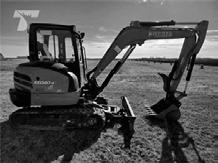



During the coronavirus pandemic, many Americans turned to online shopping and therefore often buying foreign products. Harden said there was so much demand for goods coming into the U.S. that it was often cheaper for ships to unload their goods and turn around empty than to wait for U.S. goods to be loaded.
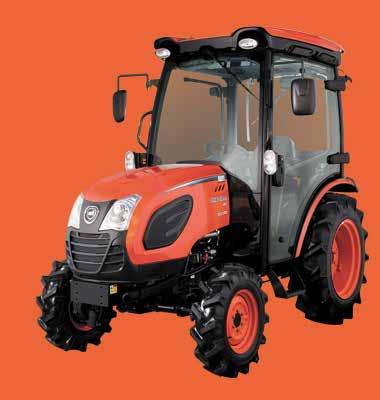





“The inbound, imports, were so great,” she said.
Moving products by rail and truck has also been a roadblock to exporting U.S. dairy products.



The Ocean Shipping Reform Act has eased some of the barriers.

“It is better,” Harden said. “It’s not xed, but it is better right now.”
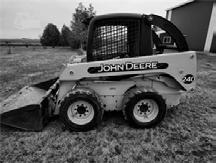
Ination is also impacting the potential for countries to afford American goods.
“The pandemic really taught us all lessons that we are going to deal with these types of issues in different ways, and we don’t need to be dependent on just one country or one region,” Harden said.
The biggest competitors of the U.S. dairy industry are New Zealand and Europe, Harden said. But, New Zealand and countries in Europe are land locked, giving the U.S. the advantage because of its size and space.
“We know what we’re doing here, and we know how to do it very well,” Harden said.
Harden said the biggest importer of U.S. dairy is Mexico. Harden said the two countries have a good working relationship.
Other countries include China, Southeast Asia, Japan and Korea.
Harden said the U.S. is seeing consistent growth of imports to South America, the Middle East and northern Africa.
The USDEC opened an ofce in Singapore in 2020 and serves the 16 countries which make up Southeast Asia. The center includes a test kitchen to help nd new ways to use dairy products in the area’s cuisine.
China, because of its population, has been a key market for U.S. dairy.
Harden said the Chinese government has recommended consumers use more dairy in their diets. The USDEC has noticed an increase in products such as butter and whole milk powder.
“We work with local cultures to make sure it is incorporated into diets that just need fortifying,” Harden said.
South America, especially Chile, has been steadily increasing their imports of U.S. dairy.
“Our strategy has been to be as diversied as possible,” Harden said.
One product seeing an increase in demand is cheese. About 3,000 varieties of cheese are exported, and artisan cheeses are popular. Chile has the highest gross domestic product in South America; therefore, consumers have disposable income and appreciate U.S. cheese, Harden said.
“The Middle East is also very interested in our cheese,” Harden said. “That’s all they want to talk about.”
When the USDEC was created 27 years ago, the U.S. was exporting 2%-4% of what the country produced. Today, the U.S. exports 18% of its’ total production.
Looking ahead, USDEC expects the focus on health and wellness to continue. With dairy products being nutrient dense, the USDEC sees this as an opportunity to promote American dairy.
Harden said pizza is gaining in popularity across the globe bringing with it a demand for cheese. And, USDEC is working to nd ways to encourage other countries to incorporate dairy into their mainstay foods.
“Nobody works harder in the world than the dairy farmer,” Harden said. “The future is really bright for U.S. dairy. I would say to dairy farmers that the future is really for yours to drive. The world wants our products and needs our products. We can help nourish a very hungry, food insecure world.”
consult but maybe have another career beyond this.”
The family has taken steps to make a transition possible by appealing for a larger quota from Organic Valley. The Vosbergs have until 2024 to raise milk production before setting a ceiling.

With their intentions focused on passing on the farm, the Vosbergs installed a used Germania double-12 herringbone parlor last year. The parlor was retrotted into the farm’s existing tiestall barn.
The cows were housed in a freestall barn prior to installing the parlor, so production did not vary. However, with the addition to the freestall barn that went in last year as well, there is more room for the springing heifers to join the herd, which Vosberg said will help them reach their goal of increasing milk production.
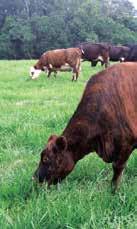
Vosberg said the older cows did not adapt well to the parlor.
“My nutritionist did say
that the old cows were going to nd their way out the door, and he was right,” Vosberg said. “They didn’t adapt. A few older cows are still here, but we’ve got a very young herd right now and a lot more coming in.”
The family also implemented an automatic feed pusher.
Since transitioning to organic farming in 2002, Vosberg saw a steady decline in crop yields every year. After talking with others, he heard about composting manure and rst tried the method in 2019.
To do this, manure is spread thin on a 30-foot evaporation lane. After 24 hours, the manure is dry. It is spread on the evaporation lane every day, and when it reaches approximately knee high, the lanes are pushed up and the pile is churned. In a matter of months, the pile looks like soil and can be spread onto elds.
The method requires a tractor with a hydrostatic
transmission that can go slow enough while still exerting the power needed to run the compost turner. Other equipment includes a compost turner and spreader.
“It was a little bit of an investment, but our yields are signicantly better,” Vosberg said. “Before, our hay would zzle out as the crops went. This year, we made ve crops of hay, and the fourth crop was just as good as the rst. The fth wasn’t bad either.”
Vosberg said the cost of the compost equipment has already paid for itself compared to what he used
to pay to empty the manure pit twice a year. He also said composting sequesters carbon, and the farm receives carbon credits for utilizing the method.
With ideas already in practice, Vosberg is open to even more ideas from the next generation.
“It’s a lot of pressure because now we have to gure out how to make the farm big enough to support all these people,” Vosberg said. “Tabitha has a lot of good ideas, and I told her to keep them coming.”
Vosberg said his previous career served him well, even though he does not
miss the work.
“I learned a lot and gained a lot of condence, but every time I would be on a dairy farm where a young couple was making it happen, I thought, ‘Oh man, I could do this,’” Vosberg said. “I wanted to get back to this area.”
Even though Vosberg knew he could carry out the demands of being a dairy farmer, he said switching from his career to the farm was an adjustment.
“It’s only by God’s grace that we were able to survive,” Vosberg said. “It’s been a wonderful place to raise a family.”
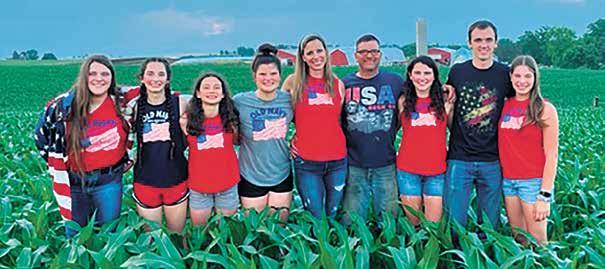
“It’s only by God’s grace that we were able to survive. It’s been a wonderful place to raise a family.”
TIM VOSBERG, DAIRY FARMER
Brandon’s wife, Shianne, takes care of the calves and heifers at their farm, which total 100 head. She also helps at the main farm if needed. The couple now has four children Bryleigh, Ryker, and twins Corbin and Ledger. For two years, Brandon and Shianne rented his parents’ farm in Pickett before purchasing their current farm in 2012. Brandon and Shianne milked 70 cows in a tiestall barn before joining Tim.
Tim was able to reduce labor by two employees, as Brandon lled their shoes when he took over day-today tasks on the farm. Three employees milk the cows while Tim and Brandon feed and handle breeding, treating sick animals, drying up cows and other daily chores. Tim used to hire out the breeding, but now Brandon does it all.
“My dad and I each have our areas we focus on,” Brandon said. “My dad does most of the feeding, and I do the majority of cow health. It works well.”


Brandon no longer milks since moving his cows in with his dad’s.
“I still spend time in the parlor assisting with the two high groups of cows, but it’s denitely a big change not milking every day,” Brandon
Cows are housed in this 240-stall freestall barn the Ferrys rent
Ferry has milked at this loca on for 12 years.
said. “I always enjoyed milking. It gives you time to think.”
The Ferry herds are Holstein with Jersey and Brown Swiss mixed in. Brandon also has Ayrshire and Milking Shorthorn heifers. Brandon’s cattle are registered under the prex Fer-Crest, while Tim’s cattle use the prex Fer-Li.




“The cattle are together, but we keep each herd under our own prexes allowing us to maintain our own genetics,” Brandon said. “Shi and I have
always focused on the genetic side. Since moving our herd, we still try to build off pedigrees and sire stacks and focus on genetics. Dad has a handful of registered cattle with good pedigrees also, but the majority of his herd is bred from a commercial standpoint for production and longevity.”
All expenses come out of the farm, and Brandon and Shianne receive payment for 40% of the milk their 80 cows produce, which equates to 7% of the gross milk check.


“Dad is covering all the
overhead, so it’s like we’re each getting a wage,” Brandon said.
Together, their rolling herd average is around 25,000 pounds of milk, and the Ferrys ship their milk to Baker Cheese. Brandon and Shianne emphasize type in their herd and have a BAA of 112.8, consistently putting them in the top 50 on the national list.


Previously housed on pasture mats bedded with wood shavings, Brandon said his cows are enjoying the comfort of sand-bedded stalls.
He makes an exception for his show cattle, housing select animals at his place.
“I keep the really good stuff at home and currently have four high-end cows at my farm,” he said. “I can keep a closer eye on them and feed them different during the show season.”
Brandon judges dairy cattle shows throughout the country and recently judged the junior Jersey show at the North American International Livestock Exposition in Louisville, Kentucky. Brandon also manages a tie-in string of 20 to 30 head at major shows.
“Between showing and judging, I can be on the road quite a bit,” he said. “The arrangement we have with my dad makes it easier for me to travel. Before, Shianne used to take care of everything, but the kids and farm became too much for one person to handle.”
By teaming up with his dad, Brandon laid the foundation for long-term success and took the burden off his young family.
“Initially, my dad and I didn’t farm together because we’re too similar,” Brandon said. “We have different ideas and viewpoints on farming, so it was good for me and Shianne to do it on our own as long as we did. But we hit a point where we needed him, and he needed us. We get along pretty good now.”
REEDSBURG, Wis. – Janice Hill is a rst-generation dairy farmer who has spent the last 14 years working her way through challenges as she pursued milking cows.
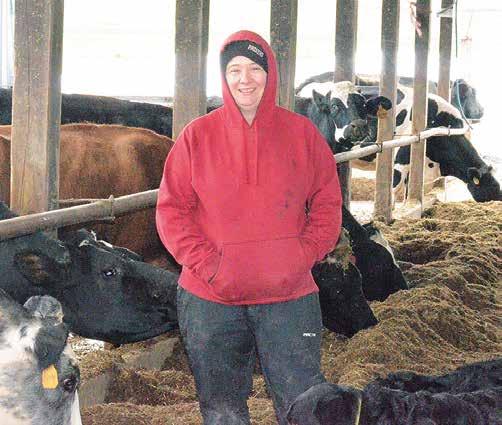
She has battled low milk prices by working off the farm and overcame stray voltage with the help of a nutritionist.
She does it all out of love for her animals.
“I enjoy the milking,” Hill said. “Just the cow contact and the connection to the calves.”
Hill milks 45 cows near Reedsburg. Cows are housed in a sand-bedded freestall barn and milked in a stanchion barn. She farms 100 acres to put up most of her own feed and has 30 acres of pasture for heifers in the summer.
Hill grew up dairying on her parents’ farm but decided to work for a year in 2007. She obtained her commercial driver’s license and hauled equipment for an asphalt and paving crew before the call to dairy brought her back to the Reedsburg area.
“I got a lot of experience out west, but I missed the cows and missed farm life,” Hill said.
Hill returned to Sauk County and bought her farm in 2008. Milk prices were $18 per hundredweight when she purchased her farm and dropped to $9 cwt the following year.
“I denitely drowned nancially for the rst eight years,” Hill said. “Thank God for good people taking payments and having faith, because if it wasn’t for them, there is no way I would’ve made it.”
Hill fell back on her experience driving truck and worked off the farm once milk prices dropped. She would milk at 3 a.m. in order to get in the truck by 7 a.m. and sometimes not return home until after 6 p.m.
When the schedule took a toll on the dairy, Hill decided to quit the day job and focus on her cows.
Meanwhile, the somatic cell count had been creeping higher and higher her rst few years on the farm. Hill discovered the vacuum pump was not putting out enough power to properly run her four milking machines. Upon further investigation, she discovered stray voltage issues from the bulk tank cooler and a couple silo unloader mo-
tors as well as the vacuum pump.
“The cell count just creeped and creeped, and then, it skyrocketed,” Hill said. “The cows started having health and reproductive problems. Finally, I found a guy that started nding all of it.”
The help came from John Sheer, a nutritionist who had a reputation for helping people with stray voltage. Hill said it took a long time for the herd to recover from all of the setbacks of stray voltage.
“John taught me that you can never cull your way out of a cell count problem because it’s normally your best cows that have the high cell count for whatever reason, and that was so true,” Hill said. “Some cows did go out the door, but if I would have culled like some people would, I would have lost all my best cows. You just have to work with them.”
Hill has continued to work with Sheer for nutrition and consulting work.
Hill said not having equipment loans has been benecial.
“I started off with a tractor, a (mixer) and a spreader,” Hill said. “Now, I have a decent skid steer and a decent tractor, but I don’t have a lot of equipment debt.”
In order to keep equipment costs down, Hill hires planting and chopping every year. She sometimes has to supplement feed with purchased hay or corn but usually gets pretty close with what she grows on her acreage.
The herd is fed a total mixed ration, and Hill raises most of her youngstock.
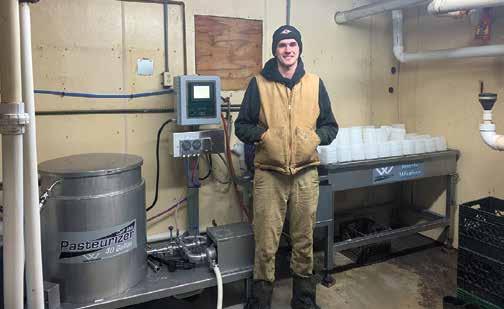
Hill manages the dairy with the help of one hired man who would like to start his own dairy in the next few years. After working a job in town, he milks for Hill at night and on his days off and is building equity in the meantime. So far, he owns eight cows which are housed on Hill’s farm.
“It’s more work that he has cattle here, but he’s here every night so I can’t ask for much more than that,” Hill said. “It’s the most reliable help I’ve ever had.”
Hill’s friends, Katie and Thom Statz, and their children, Raelynn, Olivia and Walter, help when Hill is in a pinch, and her parents, Brian and Peggy Hill, have offered support throughout her endeavor as well.
“My parents have been my biggest supporters and helped a lot,” Hill said. “Especially at the beginning.”
Hill said she enjoys different breeds of cattle and has started to incorporate beef breeds into the herd.
Hill’s herd includes Brown Swiss,
Lineback, Milking Shorthorn, Normande, Holstein, White Park and Dutch Belted.
Hill said she anticipates transitioning out of the dairy industry within the next ve years.
“It’ll be really hard to do nancially, and mentally, I’m really attached to the cows,” Hill said. “But, it’s hard to get away, and it’s hard to rely on anyone.”
Hill said her hired help will be on
his own by the time she transitions away from milking cows.
When she is not farming, Hill enjoys giving children who live in town the opportunity to show animals at the Sauk County Fair. She has one goat named Maddie that goes to the fair every year, and there are usually a string of calves that make the trip as well.
“It denitely can be draining, but I keep plugging along,” Hill said. “It’s where my heart is.”

“We began looking at a bottle washer to keep bottles cleaner and eliminate an extra job. After seeing the option to purchase the bottle washer and pasteurizer combination, we started to look at its benefits. Once we calculated what we would save by not buying bags of milk replacers, it was an easy decision to add the pasteurizer. Since installing the new system of the bottle washer and pasteurizer combination the calves drink better and are healthier.”Owen Murphy Murphy Dairy Farms Farley, IA ABBY WIEDMEYER/DAIRY STAR Janice Hill checks on her animals Nov. 14 at her farm near Reedsburg, Wisconsin. Hill milks 45 crossbred cows and farms 100 acres. ABBY WIEDMEYER/DAIRY STAR Youngstock rest Nov. 14 at Janice Hill’s farm near Reedsburg, Wisconsin. Beef breeds are incorporated into the dairy herd.

HARVARD, Ill. – The Davidson family has farmed in northern Illinois for more than 130 years. Starting out milking 13 cows, Richard Davidson’s great-grandparents immigrated from Ireland, and in 1889, they settled at a farm established during the Civil War. From generation to generation, the Davidsons worked together and grew their farming operations beyond that of the original farm.
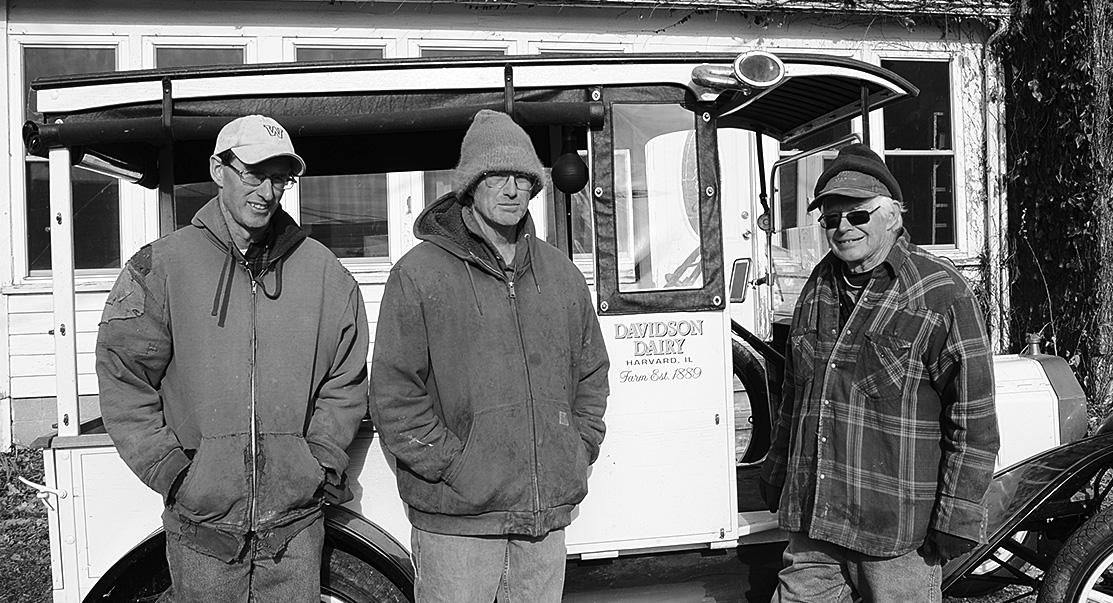
“At one time, our family had four farms with cows on them,” Richard said.
Richard and Ella Davidson and their two sons, Gary and Andy, who are the fth generation, are the last of the Davidsons to milk cows. Operating two separate farms, Gary farms with his parents while Andy farms a mile down the road. However, a spirit of cooperation meshes the work into a seamless ow from farm to farm.
“Andy and I are not partners, but we work together,” Richard said. “We help each other out, and it benets both farms.”
Milking partially in a barn built during the Civil War, Richard and Gary milk 84 cows in an 84-stall stanchion barn. Andy milks 50 cows in a 56-stall tiestall barn.
“We usually sell eight to 10 cows in the fall to get down to a barn full,” Gary said. “Milking a second shift takes too long.”
The barn has been added onto over the years, but the original parts are still in use. A glass pipeline was installed in 1962 and is the same pipeline the Davidsons use today.
“It was the cutting edge of modern back then,” Richard said.
Richard and his father and two brothers farmed in partnership on the home farm; therefore, Andy stepped out on his own in 1996 after graduating from the University of Wisconsin-Platteville. The farm was owned by Richard and his brothers and parents. When his grandpa died, Andy bought out his grandma’s share in 2009 to become an owner.

Richard’s dad did not have a will, leaving his sons to gure out how to split up the farm when he passed. Richard’s brothers inherited separate farming operations, while Richard remained on the original Davidson farm.
“We were sort of in the process of separating operations anyway, but it made it more difcult without a will,” Richard said. “Things were entangled.

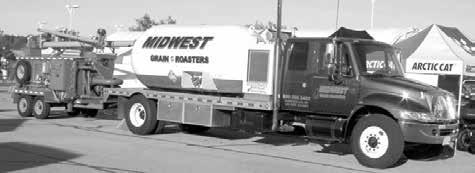
We bought land together in a combination of different owners. I took over the land with debt and paid it off, and nobody in this family has had any debt since. We’ve been staying away from debt. If we don’t have the money, we don’t buy it.”
Richard and his dad and brothers owned 1,000 acres of land in partnership. Today, Richard and his sons farm around 500 acres, which includes 200 acres of alfalfa, about 200 acres of corn, 50 acres of wheat and 50 acres of grass.
“It was a really good crop year this year,” Richard said.
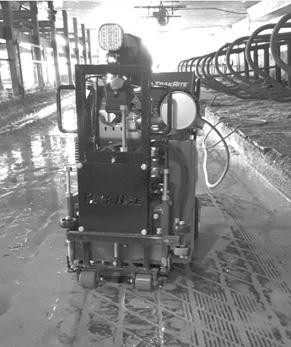
The Davidsons hire out the planting, spraying and combining of corn as well as silage harvest.
“We do our own hay,” Richard said. “Andy has the big baler and the rake, and I have the Haybine. Sometimes we get too much cut, so we have to hire someone to help catch us up.”
Andy bought a new round baler last year and made more than 1,300 bales.
Cows go outside to eat during the day. At both farms, the Davidsons feed round bales of hay in feeders along with corn silage. No ration is fed. Small square bales provide overnight hay in the barn. The cows also eat pasture when in season.
Both herds are made up of registered Holsteins. Half of Richard’s herd and one-third of Andy’s herd are Red and Whites.
“We started with Reds in 1970 when I was a young man picking sires,” Richard said. “I knew we had cattle that carried the red gene. We used PineyHill Majority and got ve or six Red and Whites out of all black cows. Then Triple Threat came along, and we used him quite a bit and built up our Red and White herd over the years.”
A love for genetics and breeding quality cattle guided the Davidson farm mission for many years.

“There’s not as much demand for those kinds of animals anymore, and we sold our last show cow in 2011,” Gary said.
The Davidsons make the best of old facilities but have transitioned from upright silos to using a bunker to store silage.
“We don’t cover anything, and the cows eat it all,” Richard said.
Gary agreed.
“We’re all for simplicity and less work,” he said.
A heifer facility for pre-breeding animals is located across from Andy’s farm at Richard’s sister’s place. Heifers are housed there from mid-March to Nov. 1 and return to Richard’s farm during the winter. Breeding-age heifers from both farms are housed at Richard’s farm.
“We break the springers to milk, and then Andy comes and gets his and takes them back to his farm,” Richard said.
Each farm raises their own calves, except for those born of springing heifers – their calves stay at Richard’s.





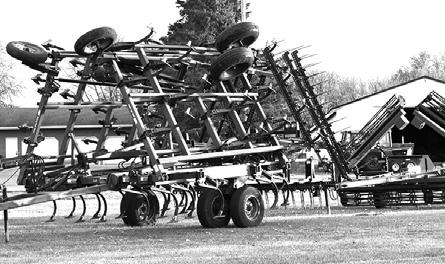

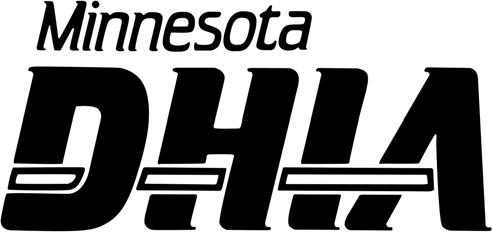
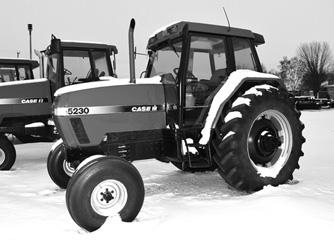

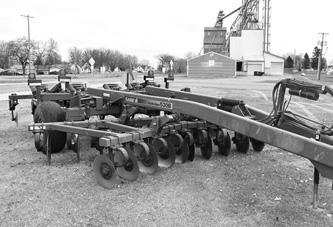



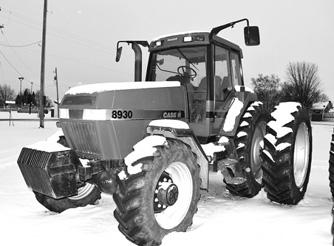


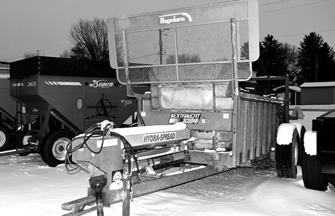
“I have limited space at my farm, so this arrangement works out well,” Andy said.
The Davidsons know that backup is never far away and have come to rely on each other on a daily basis. And woven into their love for farming is their love for history. Richard adds his treasures to those store by family members who came before him.

“I’ve also become a collector,” Richard said.
His house, which is known as the Jacob A. Wood house, was built in 1876. The grand home was considered a mansion in its day and built to be used as multi-family living featuring separate entrances and common rooms. The dinner bell on top of the house still functions today.
“Generations before me moved in, lived here all their lives and then died,”
Richard said. “Then the next generation came in. That’s how we ended up with so much stuff. We still have the trunk that my great-grandmother used when moving here from Ireland.”
A museum of sorts can be found in one of the upstairs bedrooms containing priceless relics from the past. An antique rocking horse, sewing loom and other rare pieces ll the space. In 2015, Richard had his great-grandfather’s 1915 Model-T milk truck restored. Now, he uses the vehicle to take his grandchildren for rides.
The farm was originally owned by Wood. Rumor has it, when his sons wanted their money after coming home from the war, he pointed at the barn and said, “Here it is.” That same barn still stands as a piece of history. The Davidsons have not felt the need to modernize beyond what they need. They continue to live the Davidson family’s passion on a farm that has stayed true to its past.

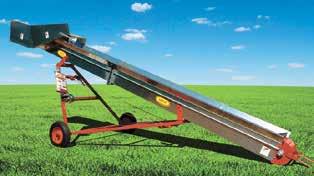

WISCONSIN DELLS, Wis. – Nick and Jackie Morse love macaroni and cheese so much that when looking to open a new restaurant in downtown Wisconsin Dells, they chose to build their entire menu around this one dish. A far cry from macaroni and cheese in a box, these entrepreneurs took a family favorite and turned it into a gourmet meal.
“We focused on quality and ways to expand on a classic dish,” Nick said. “We wanted to elevate a food that people are familiar with and make at home. To create an identity, I knew we had to make our macaroni and cheese from scratch.”
The idea was bold yet brilliant. Featuring cheese as the star ingredient, the Morses invented a culinary delight worthy of sharing with the rest of Wisconsin. Made and served in a cast iron skillet, the concept was unlike any other the state had seen before.
The Morses decided to call their restaurant MACS Macaroni and Cheese Shop and designed a logo in which the letter
C in the word MACS resembles a macaroni noodle. In 2013, the Morses opened their agship store.

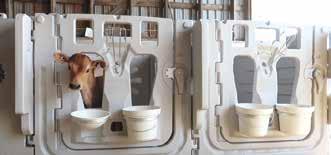

“The food here is not premade,” Nick said. “Every dish is built to order. Customers can also customize their creations.”

The dishes are called MACS. Crispy on the top and creamy on the inside, at the base of each is the cheesiest macaroni and cheese around. From there, every creation contains
the freshest ingredients, including chicken, pork, beef, onion, mushroom, broccoli or spinach, to name a few. The menu is lled with recipes for all kinds of palettes and avorful options to satisfy everyone’s inner child.
Serving fast, fresh, comfort food is what the Morses do best. Energized by tourism, these Wisconsin Dells natives seized an opportunity when they saw a prime location on the main strip become available. Jackie was
doing interior design work, and Nick was teaching at the time.
“We were looking to do something on our own, so we started brainstorming ideas,” Nick said. “We didn’t want a standard restaurant; we wanted something unique. We decided to stay focused on a single item and make it the cornerstone of our business.”
Food was a perfect t for Nick and Jackie, both of whom grew up in the restaurant indus-
try.
“We were making a lot of mac and cheese for our 1-yearold at the time,” Nick said. “We like it and know that lots of other people like macaroni and cheese too. It’s a food that transcends different age groups. Being in the heart of Wisconsin, we’re also in a good spot for mac and cheese. Doing something with dairy just made sense.”
Nick and Jackie experimented with ideas at home, making all kinds of macaroni and cheese recipes. It was a process of trial and error as they gured out which toppings made the best concoctions. Starting with 12 entrees, the Morses focused on quality ingredients and processes when building their menu.
Jackie designed their restaurant and gave it a rustic feel. A brick wall serves as an accent wall – a design element found in all MACS stores. Creating a place where people want to linger was the goal.
“A warm, inviting atmosphere is what we’re going for,” Jackie said.
MACS acquired an intense following, and the Morses opened their second restaurant almost a year to the day on the other side of town. From that point forward, a new MACS opened every year through 2019. In July, they opened their eighth location.

There are two locations in the Milwaukee area in Brookeld and Oak Creek, two in the Madison area, two in Wisconsin Dells, one in Green Bay and one in Appleton. All stores are owned by Nick and Jackie and are open every day from 10:30 a.m. to 9 p.m.
“We get lots of requests for different markets, but it has to be the right location at the right time,” Nick said. “We have a lot of out-of-state interest, but we’re not looking to franchise. Operationally, we want to keep it tight and grow closer to home without stretching ourselves too thin or hurting our product and brand.”
The family ties in downtown Wisconsin Dells are strong; the building once belonged to Jackie’s grandparents who owned The Patio restaurant.
“We get customers from all over, and this is a nice showroom,” Nick said.
The Morses staff and monitor every location and have 120 to 170 employees across all shops. The number of employees varies by season.
“We travel a lot from store to store and are fortunate to have a close-knit management group,” Nick said.
Now, MACS offers 18 macaroni and cheese dishes along with two monthly specials. The most popular creation on the menu is the chicken bacon ranch MAC featuring cheddar, mozzarella, chicken, bacon and ranch dressing. The loaded baked potato MAC is a close second containing cheddar, mozzarella, baked potato, bacon, sour cream and chives. The original MAC smothered in cheddar and mozzarella is also a crowd pleaser.
The Morses marry popular food entrees into their mac and cheese like tacos in their taco MAC featuring pepper jack, mozzarella, pico de gallo, seasoned ground beef, cheddar, sour cream, guacamole and tortilla strips. Their cheeseburger MAC with its cheddar, mozzarella, ground beef, pickles and dressing toppings satises a craving. In addition, six melts or specialty grilled cheese sandwiches can be found on the menu.
“We offer salads, too, to balance out our offering,” Nick said. “There’s something for everyone at MACS.”
Cheese, milk and butter are the soul of MACS, which takes a hands-on approach to food preparation. Chicken is shredded on-site, and the Morses’ cheese sauce is made from scratch with over 25,000 gallons made year to date. The sauce starts with their homemade roux, which is a mix of butter and our. They then add milk, proprietary seasonings and a combination of shredded cheeses as it thickens.
“The cheese sauce is Jackie’s dad’s recipe, and it’s a big point of pride in what we do,” Nick said. “Very few of our
ingredients come out of a box. We pride ourselves in doing a lot of baking and cooking. Our staff works hard to execute this, and we appreciate what they bring to MACS. Service is important to us, and we keep kitchen and order taking duties separate.”
So far this year, MACS stores have used 33,000 pounds of butter and more than 150,000 pounds of cheese.

“The dairy industry means everything to our business,” Nick said. “We started with a simple concept to hang our hat on and make our identity. But it’s not just about me and Jackie. MACS is part of Wisconsin, which is where we want to grow. The mural in every shop tells our story.”
Featuring a cow, a barn, the shape of the state of Wisconsin and other agricultural symbols, the mural depicts the essence of MACS’ foundation.
“We felt more condent in being able to specialize with Wisconsin’s history in the dairy industry anchoring us,” Nick said. “I knew we needed quality behind our dishes.”
This past summer, the Morses opened Huckleberry’s Ice Cream and Bakery next door to the downtown MACS location. The elegantly decorated dessert venue is connected to MACS, making it easy for customers to grab both salty and sweet food in one visit.
“It’s the best of both worlds – lunch and dessert,” Nick said. “Jackie designed Huckleberry’s, and it has great curb appeal. MACS has gained customers who originally came for the ice cream.”
Purchased from different providers, Jackie is hoping she and Nick can make their own ice cream one day. The couple now has three children – Julian, Olivia and Max – and raising a family while running the MACS restaurants keeps Jackie busy to the point that she no longer does interior design for other clients.
Filled with personal touches, the Morses go out of their way to make dining at MACS a memorable experience. From food presentation to the food itself, the Morses spare no detail. For example, MACS uses real butter on its toasties –the little pieces of toasted bread served with each mac and cheese dish.
“It’s painstaking, but it makes a difference in the quality we provide,” Jackie said.
MACS is a cozy place to get away from it all while escaping into a skillet of mac and cheese bliss. People walk away content after eating cuisine that warms the heart. As they continue to specialize in the one dish their customers keep coming back for, Nick and Jackie keep their eye on the right opportunity for the next location.





PULSNEXUS G2 Monitoring System
Keeping full-time watch on hose detachment, damage, & blockage; & the proper
PULSNEXUS offers:
•Adaptation to any system

•Pulsator control & performance
SCANNEXUX G2
Stand-Alone Milk Meter
this solution is not a milk yield indicator— there’s no need to lift or restrict milk to be accurate. The Stand-Alone Milk Meter offers:

•Adaptation to any system
•Pulsator control & performance
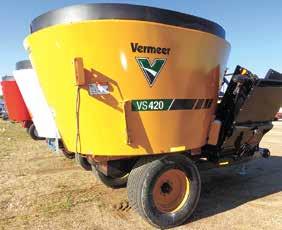
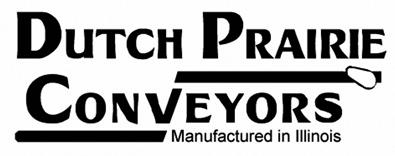




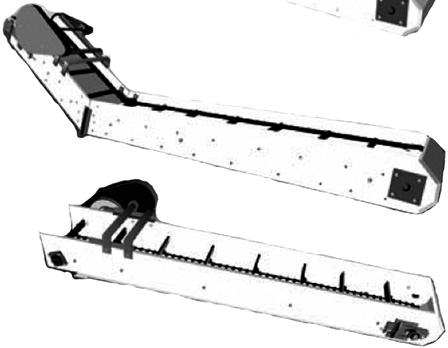


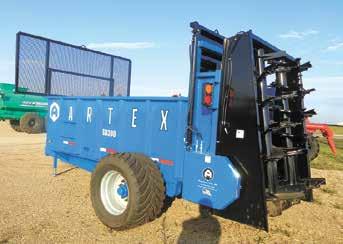



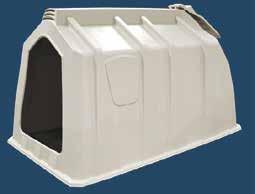
























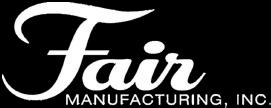






 Annie and Adam Hedlund Siren, Wisconsin Polk County 100 cows
Annie and Adam Hedlund Siren, Wisconsin Polk County 100 cows
What are you thankful for this year? I am thankful for family and friends and good co-workers. I have an appreciation of those things. I talk to a lot of people. I often ask others, “Do you have help or not?” It’s getting to be less and less people who do. But, we’re still fortunate to have good help.
Describe a moment this year that made you grateful. World Dairy Expo. We are only a part of the animals we breed or sell, and we wouldn’t be able to do what we do without the people we partner with. They are a big part of our success. Eight of the top-six nishes at Expo were animals we bred or cobred in every breed except Milking Shorthorn. We didn’t exhibit any of these cattle and wouldn’t be able to have them recognized if it wasn’t for other people. There are others continuing our hard work on that side of things and having success, and I’m grateful for them. Just being able to attend World Dairy Expo is something I’m also grateful for.
Who is someone in your life you are thankful for?
I am thankful for my kids. I have two daughters who are 6 years old and 2. They provide me with a very different mindset and different approach to life.
How do you show appreciation for the people you work with every day? The simplest answer is saying hello every single morning to everybody. Starting with positive communication is a great way to start the day. Saying thank you is also important.
How do you celebrate Thanksgiving? We get work done in the morning and go eat for as many hours as we can while visiting with both sides of the family.
Tell us about your farm. At Red Carpet Holsteins, we do extensive in vitro fertilization work almost exclusively with show cattle. We also farm about 3,500 acres, the majority of which is organic. We do some boarding and have partnerships with other breeders. We’re always looking for people who share our same interests and have good cattle they want to develop. In addition, we manufacture a nitrogen drop called EZ-DROPS. I farm in partnership with my dad, Steve, and my two brothers, Jeffrey and Gilman.
What are you thankful for this year? I am thankful for a healthy herd of cows. Cows are the top priority; they are what make us money. I’m thankful for the family that has surrounded us this past year. My fatherin-law stepped up in place of my husband, and my brother-in-law fed the cows this past year. My mom and mother-in-law have taken care of the kids while I milk.
Describe a moment this year that made you grateful. The moment I am extremely grateful for this year was April 5, when my husband received a second chance at life by receiving a pair of new lungs and the chance to see his kids grow up.

Who is someone in your life you are thankful for? Someone in my life that I am thankful for is my husband. This past year, since he has been hospitalized, it has taught me never to take anything for granted. He is my best friend, and we did everything together. To have that ripped from me is something I cannot even explain.
How do you show appreciation for the people you work with every day? We have one employee, and especially this year, she has stepped up to help our farm. To show appreciation, I like to slip treats in the milking bucket for her. I write notes on the white board for her. And if possible, I just do things that will make her chores a little easier.
How do you celebrate Thanksgiving? We go to Adam’s aunt’s house, have dinner and hang out with family. Every year gets a little more interesting because every year there are more kids added. We usually eat so much that we complain during chores about how much we ate.
Tell us about your farm. We milk around 100 cows in a double-5 parlor. The herd is mostly Holstein, but there are more Jerseys added all the time and one Brown Swiss. My husband and I own the farm, and Adam’s dad helps at the age of 72. We have one employee and a part-time milker when her or I can’t milk. We grow hay, corn and soybean to feed the cows but some is cash cropped. Adam and I have three young children. They help feed calves with me almost every night.

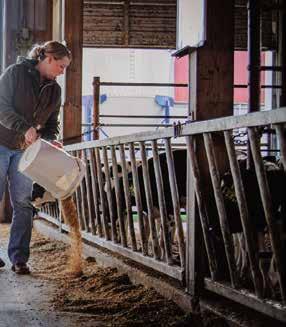
Brent Havlik Norwalk, Wisconsin Monroe County 54 cows
What are you thankful for this year? I’m thankful I’m still in business. With the price of inputs so high, it seems like there's no room for error, and things better go good. I’m also thankful for a good crop year that provided plenty of hay. I’ve got a family that supports me and helps me when I need it. We have a 2-year-old grandson who comes to the farm so that is encouraging.

Describe a moment this year that made you grateful. I enjoy spending time with family, and everyone is healthy and happy. We had no major weather disasters this year, no ooding and had timely rains we needed.
Who is someone in your life you are thankful for? My wife, Sarah, because she has always been there to support me. She’s got a job too, which helps because there are times we wouldn’t survive with just the farm income. I am also blessed with good neighbors: the Lelands, Randy next door, and Dawn and Chad Powell. They are kind of like extended family. It’s so good to have good neighbors who are willing to help.
How do you show appreciation for the people you work with every day? Thanking them for their help. Everybody is busy and has plenty to do on their own.
How do you celebrate Thanksgiving? We get together as a family at our house. We get up and do chores early to get home for dinner. We play games after the meal. Our grown kids return home to celebrate with us.
Tell us about your farm. We are an organic dairy with about 60 head. I started farming later in life, so I rent the farm. We cover 250 acres and ship our milk to Westby Cooperative Creamery.
 Johnathan Heinsohn (Pictured with his wife, Joanna, and daughters, Finley (left) and Navy.) Kirkland, Illinois DeKalb County 250 cows
Johnathan Heinsohn (Pictured with his wife, Joanna, and daughters, Finley (left) and Navy.) Kirkland, Illinois DeKalb County 250 cows
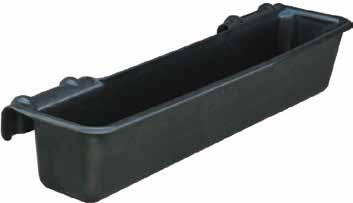





What are you thankful for this year? I am thankful for the late summer rain that broke the long dry spell we had through most of the summer. I am thankful for everyone being healthy this last year. I am thankful for neighbor farmers who we are able to depend on to help when needed, and we can in turn help them. None of us can do this alone.

Describe a moment this year that made you grateful. I was able to help my son move into his dorm at the University of Wisconsin-Platteville for his rst year studying mechanical engineering. I was grateful he was comfortable and condent enough to move more than three hours away from both myself and his father to pursue his dreams.
Who is someone in your life you are thankful for? I am thankful for my partner, Tom, who has welcomed me into his farm business over the last 3.5 years. He is consistently positive and looking for ways we can improve
Nichole Lurvey Wonewoc, Wisconsin Juneau County 200 cowsWhat are you thankful for this year? I'd like to think we always live a life of gratitude, but this year has been especially signicant in giving thanks because we've been able to make big changes in our dairy operation that have made for an incredible life change for us as a family. We were able to sell our second farm which was 50 minutes away and install robots to milk all our cows here at home. I'm thankful for time spent making memories with my husband and our three boys at home instead of being on the road. We're also giving thanks for the upcoming arrival of our fourth child.
Describe a moment this year that made you grateful. We've been blessed with so many amazing people in our life. The most overwhelming and memorable moments were when our loved ones – neighbors, friends and family – came together to help bring me home for Christmas. I was basically living at our other farm, milking cows three times a day, with great friends helping me, until the new barn was done. My husband was staying up night and day to nish the barn, and at the end, he had the most wonderful people working right beside him. We were thankful for my mother's help with the boys through those months as well.

the farm together. Our teamwork has made it possible for us both to farm full time, and I will always be thankful for that.
How do you show appreciation for the people you work with every day? Since we are such a small farm, we only work with family on a daily basis. I try to make sure Tom knows I appreciate all the extra work he puts in as well as to help him as much as I can to make his day go smoother. We do our best to make the time to do fun things with the kids throughout the year, whether it is a day at the lake or picking up ice cream from the creamery to enjoy together.
How do you celebrate Thanksgiving? This year, we will spend the afternoon of Thanksgiving with Tom’s extended family having a big meal in the church basement and playing card and dice games together. Saturday, my two kids will join us along with my mom and aunt for another small meal. The rest of the weekend will be spent relaxing and visiting.
Tell us about your farm. Tom and I milk 40 cows once a day and ship our milk to Organic Valley on the grass-only route. Our animals are rotationally grazed throughout the summer and are fed hay and baleage all winter. We raise our calves being fed once a day with nurse cows and raise our replacements as well as a few steers for us and family each year. Tom has been milking on this farm for over 20 years, and I joined the farm in 2019.
Who is someone in your life you are thankful for? I could not do life without my husband. He is the strongest and most hard-working man. His constant love and dedication to our family and the life we're making together is second to none, making every day we share here on the farm enjoyable. I'll be thankful for him every day of my life because he's given me the life of my dreams.
How do you show appreciation for the people you work with every day? We don't have any employees, but we have lots of companies we've worked with for years. We're always sure to let them know just how crucial their involvement is to our farm. I love to bake. Whenever I have anything extra, that all the boys in our house don't nibble up right away, I'm always eager to share.
How do you celebrate Thanksgiving? We love spending time with our family and friends in between chores on Thanksgiving. Oftentimes, holidays are spent gathering in our home because our family likes to make it easier for us to attend. It is pretty easy when the party comes to you.
Tell us about your farm. Twelve years ago, my husband and I were fortunate enough to nd a lender that believed in us, and we bought our farm. We milk about 200 cows in a robotic facility, raise our heifers and harvest our crops. It's a lot of work for two people with three young sons, but we love it. We're thankful every day for the opportunity to start our own farm and for the wonderful people in this small community who have been so supportive.
Deb



















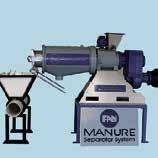































































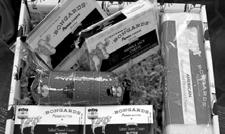

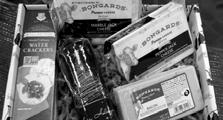
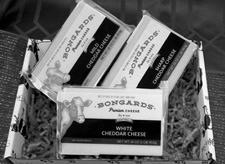







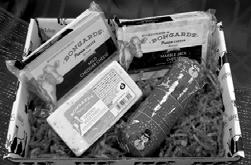
Describe your farm and facilities. The cows are housed in two freestall barns. They are both 4-row barns with deep-bedded sand stalls.


What forages do you harvest? HarvXtra alfalfa, corn and brown midrib corn for silage.

How many acres of crops do you raise? We farm 1,200 acres.


Describe the rations for your livestock. We feed the milk cows roughly 55% forage – 60% corn silage and 40% haylage – whey, corn and protein mix. Dry cows get haylage, corn silage, mineral and straw. Heifers get haylage, corn silage, hay, mineral and soybean meal.
What quality and quantity do you harvest of each crop? We harvest 10,000 tons of corn silage at 65%67% neutral detergent ber digestibility and 30%-35% starch. We harvest 5,000 tons of haylage at 150 relative feed value. And, we harvest 60,000 bushels of high-moisture corn ground to 600 microns.
Describe your harvesting techniques for alfalfa and corn silage. Sullivan Custom Farming and Co-

rey Sullivan take care of our cutting, merging and hauling needs. We chop ourselves with a John Deere chop-
per. We chop our own corn silage as Turn to FORAGE
“Starting every fresh cow and heifer with Udder Comfort™ is an important step for quality and that next pound of milk. Udder Comfort is the best product available, and it’s part of what we do for milk production and quality,” says Rick Empet, Empet Farm, Kingsley, Pa., explaining that they spray fresh udders after each milking for 5 days after calving to soften udders.







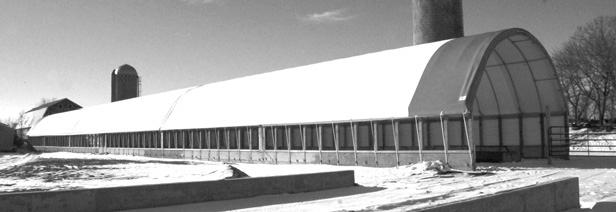
“We love Udder Comfort,” son Alex adds. Alex was excited to learn he won a free Udder Comfort gallon in the August Comfort Matters Enews drawing after signing up at Empire Farm Days. We caught up with Rick, Dana and Alex busy working on their 6th generation dairy farm. Along with son Aiden and daughter Chelsea, the family is engaged as agvocates with Chelsea serving as a dairy ambassador.



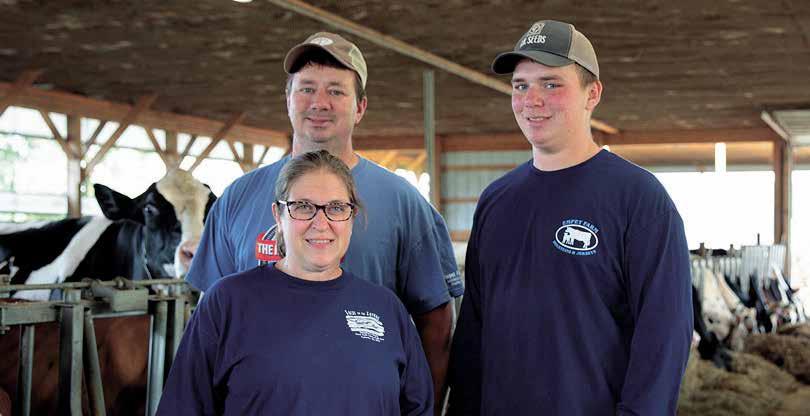
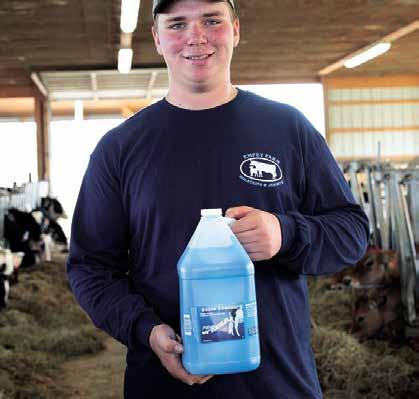
well. We cut alfalfa at a 35to 37-day interval and aim for 60%-63% moisture. For corn silage harvest, we aim for 68% moisture.
What techniques do you use to store, manage and feed your forages? All feed is stored in bunkers; we strive for a high packing den-

sity to ensure proper fermentation. Bunkers are covered immediately after lling with a vapor barrier and two layers of plastic held down by tire sidewalls. Bunkers are defaced nightly for the next morning’s feeding. We keep the face even and smooth throughout.
Lacta ng cows
the cows’ ra on comes from forages.




Describe a challenge you overcame in reaching your forage quality goals. Several years ago, we invested in a self-propelled chopper; it allows us to be efcient in putting up high quality feed in a timely manner.



How do quality forages play a part in the production goals for your herd? High quality forages allow for the
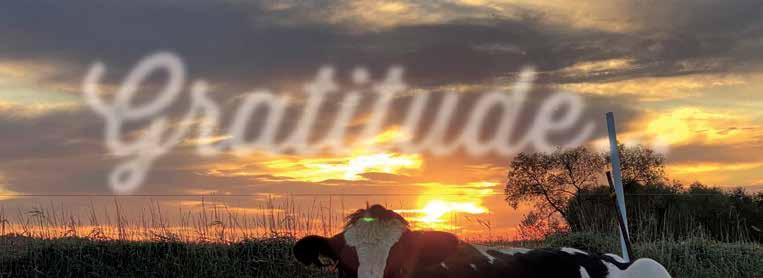
cows to be productive, reproductively efcient and improve overall cow health.
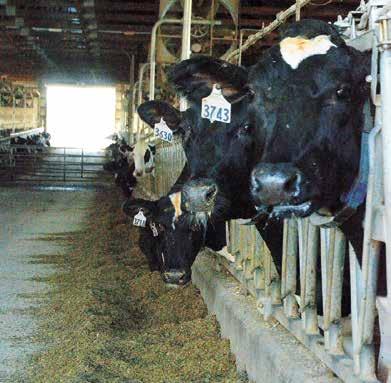
What are management or harvesting techniques you have changed that have made a notable difference in forage quality? A few years ago, we experimented with HarvXtra alfalfa. It allows for exibility in our cutting
interval, offers high digestibility and increased tonnage. We also transitioned from four cuttings to three cuttings per season. The same goes for BMR corn silage as it has increased ber digestibility. Increasing the digestibility of our own forages has allowed us to decrease the amount of purchased feedstuffs and increases overall production.
JD S680 2013, PRWD, Duals, 2485 hrs., 1604 Sep. hrs., #551147....... $165,000 JD S780 2018, PRWD, Singles, 2489 hrs., 1686 Sep. hrs., #549036 .... $274,900 JD S680 2012, 2WD, Duals, 2631 hrs., 1790 Sep. hrs., #548165 .......$147,500 JD S680 2013, PRWD, Singles , 2635 hrs., 1854 Sep. hrs., #551017 ... $173,900 JD 9760 STS 2004, PRWD, Duals, 3500 hrs., 2251 Sep. hrs., #549273 . $68,000
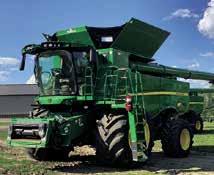
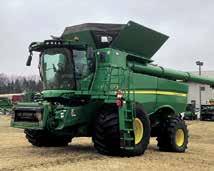

JD 9500 1995, PRWD, Singles, 3543 hrs., 2208 Sep. hrs., #551180 ...... $27,500


































Case IH 2388 1998, 2WD, Singles, 3876 hrs., 2943 Sep. hrs., #549406 $34,900


JD 9660 STS 2006, PRWD, Duals, 3925 hrs., 2453 Sep. hrs., #545355 . $72,000
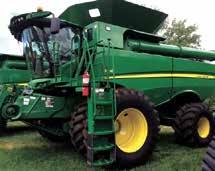

JD 9500 1995, PRWD,
9750 STS 2000, 2WD, Duals, 5299
IOWA
Prairie Land Ag Supply Inc. Rock Valley, IA 712-476-9290


United Dairy Systems, Inc. West Union, IA 563-422-5355
WISCONSIN
Advanced Dairy Spring Valley, WI 715-772-3201







Ederer Dairy Supply Plain, WI 608-546-3713
DeLaval Dairy Service Kaukauna, WI 866-335-2825
Joe’s Refrigeration Inc. Withee, WI 715-229-2321

Mlsna Dairy Supply Inc. Cashton, WI 608-654-5106
Professional Dairy Services Arlington, WI 608-635-0267
Redeker Dairy Equipment Brandon, WI 920-346-5579
The Scharine Group Inc. Whitewater, WI 800 472-2880 Mt Horeb, WI 800-872-3470
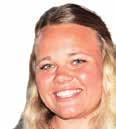
MINNESOTA & SOUTH
DAKOTA
Farm Systems Melrose, MN 320-256-3276 Brookings, SD 800-636-5581
Advanced Dairy Mora, MN 320-679-1029 Pierz, MN 320-468-2494 St. Charles, MN 507-932-4288 Wadena, MN 218-632-5416
The smell of coffee, Shania Twain on the radio and the milk pump going are the three most prominent things I keep close to my heart from growing up on a dairy farm.
Being involved in the dairy industry has always been a passion. I knew from a young age I wanted to milk cows like my grandparents and parents. Today, I can proudly say I have my own small herd of registered Holsteins.
Growing up, I enjoyed being in the show ring with my dairy heifers. My parents put me on a halter the day I could walk. From there, it grew into more than just a passion but a lifestyle. I enjoyed showing in 4-H, FFA and the Minnesota Junior Holstein Association.
By Taylor Jerde Staff WriterI come from my family’s fth-generation farm. The farm has had beef cattle, pigs, sheep, horses and of course dairy cattle. I learned what hard work was at a young age from my initial chore of feeding calves.
Even though I had my chores on the farm, I was fortunate to be able to participate in sports and other extracurricular activities. I was in volleyball, dance line, track, National Honor Society and was a senior leader. Some of my proudest accomplishments were breaking a school record in track and advancing from sections to compete at the state dance tournament for multiple years.
I recently graduated from South Dakota State University with a degree in dairy production. Throughout college, I was heavily involved in organizations and clubs. I enjoyed being active in Dairy Club, Block and Bridle, Little International, intramural sports and a small group Bible study.
Being an active person has helped me stay true to myself and be thankful for the rural upbringing I had. Like many, I value my family and enjoy spending time with them when I can. Whether it’s going to a Wild game, traveling to a cattle show, going to a dance competition or going on vacation, I always seem to follow my roots back home. I have always liked living in the country and being around animals.
My family often refers to me as the cow whisperer. I, like many farmers, have had my fair share of favorite cows. Early on, I had a calf named Carli who sparked my passion for showing. Elberta was my next favorite; she was a large Holstein who I referred to as a gentle giant. She knew exactly who I was and only ever listened to me. Stella and Time are my current favorites, as both are previous show heifers who became a little too tame to be normal barn animals.
Perhaps these animals are the reason I love being a part of the dairy industry and telling farmers’ stories. In 2020, I was a Princess Kay of the Milky Way nalist, so I am no stranger to sharing the stories of farmers. I enjoy learning about different farms and the family members who came before them.
Dairy Star is a great way for me to be able to fulll that passion. I am excited to learn about farmers, tell their stories and share the good they are doing. I look forward to continuing to share my passion.
MELROSE, Minn. – For 23 years, Joel Middendorf and his family milked in a 62-stall tiestall barn. And for the last several years, they have been switching the tiestall barn at least once to milk the farm’s 113 cows.

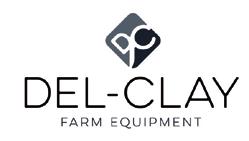
Now, in addition to farming 700 acres, Middendorf and his family – dad Eugene, wife Julie and their children – milk a portion of their herd using a DeLaval robotic milking system on their farm near Melrose.
“I look back on how much simpler things have been since April, and I genuinely don’t know how we ever made it to the boy’s football games and track meets,” Middendorf said. “The way we are doing things now has made me wonder why we didn’t put it in seven years ago when we rst thought about it.”



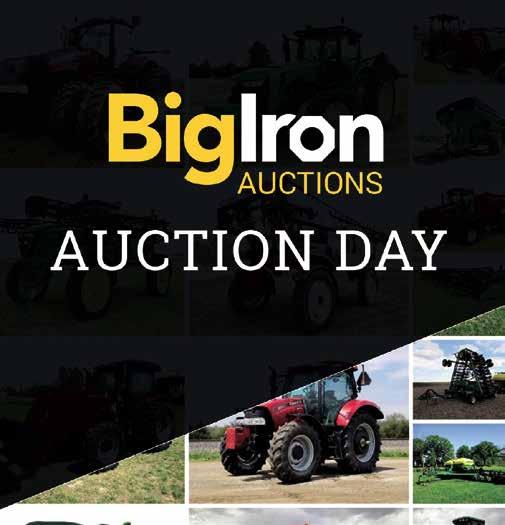
On April 14, the Middendorfs walked the better producing 60% of their herd into a new freestall barn equipped with a robot, exible stall system and rubber mats. For two weeks, the family eased the herd into its new lifestyle.
“It’s a night and day differ-
ence,” Middendorf said. “We were bedding the bed pack three times a week, and the cows just weren’t performing like they should; they were uncomfortable and that reected in our production.”

Since the transition, milk production went up nearly 20 pounds of milk per cow per day within the rst month of using the robot. Milk quality has improved, too, with a somatic cell count below 200,000.
In addition to improvements the Middendorfs have seen in their herd, the family now has more time to focus on other aspects of the farm. Middendorf said milking in the tiestall barn was taking nine hours a day.
“I think our forages this year have been way better,” Middendorf said. “I can check the barn whenever it ts my schedule. I don’t have to stop making hay to go milk, and Connie, our hired hand, takes care of milking the tiestall cows.”
The Middendorfs built the freestall barn with the next generation in mind. The Middendorfs’ sons – Gentry, Jesse and Jordy – are instrumental to the dairy and help on the farm when
they are able.
“We set it up for the future,” Middendorf said. “We have the ability to add east and then an addition west to have four total robots. We have what will suit us now, but if the kids decide to come back, in say ve years, the option to go all robotic milking
is there for them.”
The Middendorfs also implemented an activity monitoring system. The collars help record which cows are having problems during milking, who is in heat and how often the cows are getting up to eat.
All of the information is ac-
cessible through an app. They receive notications as to who has not been milked in a while, and with that information, they fetch cows and coax them to the robot for milking.



CALUMET COUNTY
• D&D Equipment
Chilton • 920-849-9304
• Stanley Schmitz Inc Appliance & Dairy Center Chilton • 920-849-4209
CHIPPEWA COUNTY
• Chippewa Farm Service, LLC Chippewa Falls • 715-382-5400
• Chippewa Valley Dairy Supply Stanley • 715-644-2350
CLARK COUNTY
• Cloverdale Equipment Curtiss • 715-223-3361
• Premier Livestock Withee • 715-229-2500
• Silver Star Metals Withee • 715-229-4879
COLUMBIA COUNTY
• Central Ag Supply Baraboo • 608-356-8384
DANE COUNTY
• Argall Dairy Systems Belleville • 608-424-6110
DODGE COUNTY
• Central Ag Supply Juneau • 920-386-2611
• Knowles Produce & Trading Co. Knowles • 920-583-3747
DUNN COUNTY
• Leedstone Menomonie • 866-467-4717
• Midwest Livestock Systems Menomonie • 715-235-5144
FOND DU LAC COUNTY
• Redeker Dairy Equipment Inc. Brandon • 920-346-5576
• Argall Dairy Systems, West Platteville • 608-348-3385
• Dickeyville Feed Dickeyville • 608-568-7982
• Fuller’s Milker Center, LLC Lancaster • 608-723-4634
• J. Gile Dairy Equipment Inc. Cuba City • 608-744-2661
• Premier Co-op Lancaster • 608-723-7023
• Scott Implement Platteville • 608-348-6565
GREEN COUNTY
• Monroe WestfaliaSurge/Koehn, Inc. Monroe • 608-325-2772
• Top Notch Feed & Supply New Glarus • 608-527-3333
IOWA COUNTY
• Farmer’s Implement Store
Mineral Point • 608-987-3331
• Premier Co-op Mineral Point • 608-987-3100
JACKSON COUNTY
• W.H. Lien, Inc. Hixton • 715-963-4211
KEWAUNEE COUNTY
• Luxemburg Motor Company Luxemburg • 920-845-2011
• Spartan Construction Luxemburg • 920-845-9892
LAFAYETTE COUNTY
• Center Hill Veterinary Clinic Darlington • 608-776-4083
MANITOWOC COUNTY
• EIS Implement
Two Rivers • 920-684-0301
MARATHON COUNTY
• Brubacker Ag Equipment, LLC Edgar • 715-613-7308
MONROE COUNTY
• Preston Dairy Equipment Sparta • 608-269-3830
PEPIN COUNTY
• Anibas Silo & Repair Arkansaw • 715-285-5317
POLK COUNTY
• Midwest Machinery Osceola • 715-220-4256
RICHLAND COUNTY
• Fuller’s Milker Center, LLC Richland Center • 608-647-4488
• Premier Co-op Richland Center • 608-647-6171
ROCK COUNTY
• Tri-County Dairy Supply Janesville • 608-757-2697
SAUK COUNTY
• Central Ag Supply Baraboo • 608-356-8384
SHEBOYGAN COUNTY
• Perfect Circle Tire Co. Waldo • 920-528-7277
VERNON COUNTY
• Koon Kreek Feeds Coon Valley • 608-452-3838
• Premier Co-op Westby • 608-634-3184
ALLAMAKEE COUNTY
• K & R Feed and Grain Dorchester • 563-568-4513
DUBUQUE COUNTY
• Brunkan Equipment Worthington • 563-855-2434
• CJ Beeps Equipment Farley • 563-744-5010
• Eastern Iowa Dairy Epworth • 563-876-3087
• Helle Farm Equipment Dyersville • 563-875-7154
• New Vienna Ag Automation New Vienna • 563-921-2896
• Roeder Implement Dubuque • 563-557-1184
• Scherrmann’s Implement Dyersville • 563-875-2426
• Skip Breitbach Feeds Balltown • 563-552-2393
• Ungs Shopping Center (IAS) Luxemburg • 563-853-2455
HOWARD COUNTY
• Farmers Win Co-op Cresco West • 563-547-3660
WINNESHIEK COUNTY
• Brynsaas Sales & Service Decorah • 563-382-4484
• Franzen Sales & Service Fort Atkinson • 563-534-2724
• Lang’s Dairy Service Decorah • 563-382-8722
• Midwest Machinery North eld • 507-645-4886
• Werner Implement Vermillion • 651-437-4435
• Caledonia Haulers Caledonia • 507-725-9000
• ESB Bank Caledonia • 507-725-3329 Eitzen • 507-495-3321 La Crescent • 507-895-2227
• Farmers Win Co-op Caledonia • 507-725-3306 Houston • 507-896-3147
• Hammell Equipment Eitzen • 507-495-3326
• Midwest Machinery Caledonia • 507-725-7000
• Ag Partners Farm Store Goodhue • 651-923-4496
• Midwest Livestock Systems, LLC Zumbrota • 507-732-4673
• Midwest Machinery Cannon Falls • 507-263-4238 Wanamingo • 507-824-2256
WABASHA
• Ag Partners Farm Store Plainview • 507-534-2531
• Beck Implement Elgin • 507-876-2122
• Leedstone Plainview • 800-548-2540
• Midwest Machinery Plainview • 507-534-3116
• Wingert Sales & Service Plainview • 507-534-2285
WINONA
• Elba Co-op Creamery Elba • 507-796-6571
• Lang’s Dairy Equipment Lewiston • 507-452-5532
• Lewiston Rentals and Repairs Lewiston • 507-523-3564
• Midwest Machinery St. Charles • 507-932-4030
*Enter as often as you like. One entry per store visit, please. Winners must be 18 years or older and a Grade A or B dairy farmer for adult prize, or 17 years or younger and a son or daughter of a Grade A or B dairy farmer for heifer calf. Winners must also live in the Dairy Star circulation area to be eligible and are responsible for transport of animal.
Middendorf said in the next few months, he would like to increase the number of times the cows visit the robot from around 2.6 to closer to three



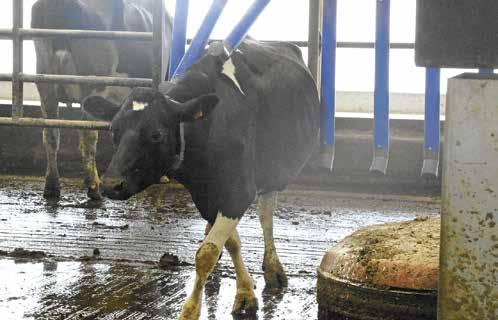



“There are already several cows that go to the robot three times a day, but I want that number to be higher,” Middendorf said. “I haven’t had to treat anyone in the barn yet for mastitis, which means they are going to the robot often enough, and their quarters



aren’t being over milked.”
Middendorf said he appreciates that the robot pulls the milking unit off each individual teat, which prevents over milking. He said when milking in the tiestall barn, the units are watched closely, but because no quarter is the same as the next, some cows are over milked.


Middendorf said the 43 cows being milked in the tiestall barn have seen production improvements too. Without
having to share space with the rest of the herd, those cows are more comfortable and easier to manage.
“Connie wanted to keep milking for another ve years in the tiestall barn,” Middendorf said. “I’m ne with that, because we are still making use of the barn, and we milk the fresh cows there once before rotating them into the freestall barn.”
With their herd on an upward trend,
the Middendorfs are looking forward to the continued use of robots for both themselves and the next generation should they decide to take over the family farm.
“There is so much to be learn about these robots,” Middendorf said. “But I already know that I like it, and I want to learn more about it to help my herd improve.”
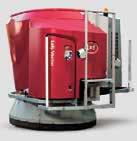

LA CROSSE, Wis. – Many farmers are hesitant to begin transition planning because they think they need to have all the answers before speaking with a professional.
Kelly Wilfert, an agricultural attorney from Green Bay, said all a farmer needs to know is their ideal situation for their farm. The rest of the details can be gured out together with a professional.
“If we’re doing transactional work like succession planning, your imagination can sometimes be the bounds,” Wilfert said. “There are some rules that we have to keep in mind, but if you come up with a goal of what you want the farm to look like, we have a lot of options as far as how to do that.”
on the funding they will need for regular maintenance or expansion of the farm, and the overall viability of the farm.
“It’s not only balancing what the folks who are passing the farm on want but also what does the farm itself need in order to keep running,” Wilfert said.
Besides the primary owners, Wilfert said it is important to include third parties who may not be driving the conversation but need to know what is going on. This can include siblings, spouses, advisors, creditors, investors and business partners.
With so many people involved in the planning process, Wilfert stressed the importance of exibility in a succession plan.

When putting together succession planning documents, Wilfert said plan for change, such as losing or gaining a person.
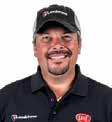 Kelly Wilfert agricultural attorney
Kelly Wilfert agricultural attorney






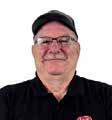
Wilfert spoke Nov. 4 about the transition process as part of a succession planning workshop hosted by the University of Wisconsin-Extension.

Because farm succession involves the future of the farm by transitioning the farm from one owner to another, Wilfert said the rst place to start is by identifying who is on the team. This includes the primary owners and the primary successors. Oftentimes, these are parents and children but not always.
Wilfert said as an attorney, she can only represent one party, the primary or succeeding party. According to Supreme Court rules, attorneys must avoid conict of interest for their client.
“In succession planning context, we have the farm entity, current owners and future owners,” Wilfert said. “What’s best for one might not be the best for the other. Technically, their interests are averse to each other, and sometimes those parties could and should get their own representation.”
Once the primary parties are established and represented, consideration needs to be given to each member’s stage of life and needs going forward. The current owners need to consider their source of income after selling the farm, whether they will need long-term care and what kind of lifestyle they are going to maintain after they leave the farm.
For the next generation, the focus is
“That plan is going to have to adapt and change,” she said. “We want to make sure that our plan is still set up to allow some exibility.”
Beyond the members of the farm changing, if succession planning starts early on, needs and dreams can inevitably change as people age. In that case, exibility is just as important. Most times, farm successions take time to implement.
“These plans typically are not happening in the snap of a nger where we plan today, do it tomorrow and all move on with our lives,” Wilfert said. “They take a while to play out.”
In order to implement a transition, a series of tools can be used like a sale, trust, gift or a combination. Other tools, which Wilfert refers to as emergency tools, include a medical and nancial power of attorney.
“Agriculture is a high-risk industry, so we strongly encourage folks to set these up and revisit them regularly,” Wilfert said.
All of the documents involved with succession planning are what most commonly scare people away from the process, Wilfert said.
Wilfert said to use resources such as an attorney, the extension ofce or a similar organization to get help with the technical details.
Protecting the future of the farm is important, Wilfert said, and people should not let insecurity stop them from securing that future.
“I strongly encourage farmers to not worry about knowing what the plan is but know what the goal is,” Wilfert said. “Once we know what the ideal world is, we can bring everyone together and create a vision for the transition.”



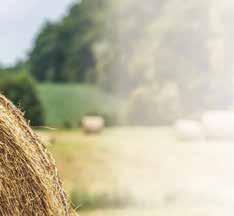

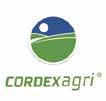
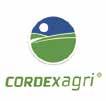
Green County 62 cows
Family: My husband, Todd, and I have been married for 34 years. We have one son, Jake, who is 29. He is a horticultural assistant and native plant specialist at RES Great Lakes/Taylor Creek Restoration Nurseries in Brodhead, Wisconsin. We also have a daughter, Paige, who is 26. She is a registered behavior technician at Arizona Autism United in Phoenix, Arizona.
Tell us about your farm. We milk 68 registered Holsteins in a New York tiestall barn. The cows are fed a total mixed ration. They’re on pasture in the summer and fall as long as weather permits. They are fed at an H-bunk in the pasture in the summer and fall. In the winter, they’re out for exercise for a couple of hours with feed available at a J-bunk. We have only 27 acres of tillable ground, so we make all our corn silage and purchase all the hay, shell corn and commodities. Our focus has always been on working with the cows, building strong pedigrees with great longevity. Our herd BAA is currently 111.4%, putting us in the top 200 in the country for BAA for the last 20-some years. Currently, we are ninth in the country for our herd size. Merchandising animals from the families we’ve been building has always been a key to our success. We consign animals to many sales and have sold animals across the country as well as exported around the world. When our kids were younger, we were very active in the show ring as well showing at 4-H shows, district and state Holstein shows, and World Dairy Expo. Now that they are grown and off the farm, I wonder how in the world we had time to do it all. Our workforce consists of mostly Todd and myself. Jake helps with chores on weekends and evenings when he’s not traveling for work. Paige likes to get home to visit as often as she can and enjoys helping as much as possible. My father-in-law, EJ, comes every morning and helps mix the TMR.

What is a typical day like for you on the dairy? The rst thing I do is help get milking underway. We always have a few cows to switch in and out, so I help until we’re past that point. Then, I feed the weaned heifers and baby calves. My weaned heifers (3 months to 10 months) get fed 4 pounds/head of 16% grower twice per day. The baby calves get a half-gallon
milk replacer and 4 pounds of 18% starter twice per day. I usually have between 10 and 20 babies and 30 or so heifers up to breeding age. After 2 months of age, all the heifers have free choice grass/alfalfa hay available. Once I’m nished with calf chores, I help with the rest of the barn chores (cleaning, bedding, etc.). After I’m done in the barn, I’m able to take care of the household tasks – advertising, grocery shopping, lawn mowing, bookkeeping, calf registration, meal preparation, laundry, etc. House cleaning is last on my list of things to do.
What decision have you made in the last year that has beneted your farm? Thirty years ago, I gave up my job as an art director at an advertising agency in Madison to be a stay-at-home mom. I started my freelance graphic design business, Spring Creek Design. I built my clientele into almost exclusively dairy and ag-related clients. It was perfect to have this business where I could be at home with my kids and still be available for farm work. Within the last couple years, I’ve really pared down my graphic design, narrowing my clients down to just one, who I especially enjoy working with. This decision allowed me to transition into a more fulltime role with the day-to-day work. As our kids grew and started their own careers off the farm, it was really important to me that I could work more on the farm. As all farmers know, every day is a ton of work, and for my husband to be doing most of it alone was tough. I feel good that I can be of more help.




Tell us about your most memorable experience working on the farm. I would say most of the really memorable experiences revolve around classication. Working all night washing and clipping to get ready for the classier, and then taking

the few hours, absolutely dead on my feet while he or she scored the herd, is a feeling I’m sure I’ll never forget.
What have you enjoyed most about dairy farming or your tie to the dairy industry? There are a couple of things I’ve truly enjoyed. First, all the showing we’ve done together as a family. When our kids were younger and involved with 4-H and Junior Holsteins, the show season was very busy. They had a lot of great success – each one of them being able to show a Junior All-American nominee or two. Everyone had their role, whether it was being home to get things done or taking care of the string at each show. The second favorite thing has been meeting many people from all over the place. Over the years, we’ve been honored to host many tour groups to our farm. I’ve enjoyed meeting other breeders from all across the country as well as many international guests. We hosted one of the ofcial WDE tours a few years ago when bus loads still came right to the farm. That year was especially fun; we met groups from Japan, Brazil, Argentina and Canada.

What is your biggest accomplishment in your dairy career? I’m most proud of how I have learned this life. I didn’t grow up anywhere near the dairy industry. The rst time I was ever on any farm was when I visited my husband’s family farm when we rst started dating. It was a totally foreign environment. So, I’m pretty amazed at how much I learned about this life, the partner I became and how together we built our herd into what it is today. I’m also proud of my overall involvement in the industry. I served 12 years as the Green County Junior Holstein advisor. I was also the 4-H dairy leader the whole time my kids showed in 4-H. Putting together educational dairy displays and helping kids
with their showing was rewarding. This year, I was chosen as the Green County Senior Agri-Business Woman of the Year, which was a huge honor.
What are things you do to promote your farm or the dairy industry? We promote our herd through advertising in the Cattle Connection. We’ve been advertising in that publication since its inception. It’s a great way to connect with breeders from around the globe. We’ve also been utilizing social media as it has grown into such a huge industry. I try and post current photos of individuals and pedigree information as well as any news that is affecting our farm. Having not grown up on a farm, I have many friends and family who are completely unfamiliar with the dairy industry and animal ag in general. I make myself available to them to answer questions, dispel misinformation and make them more aware of how our industry affects their daily lives.

What advice would you give another woman in the dairy industry? Women can do anything in this industry. In the 35 years we’ve been farming together, there are women in so many roles that were traditionally for men. Farm managers, veterinarians, feed specialists and A.I. technicians; there’s not much a woman cannot do in this industry.
When you get a spare moment, what do you do? Having gone to school at the University of Wisconsin-Madison, I enjoy following all the Badger sports. Anyone who knows me knows how much I love my herd of barn cats. If there’s a batch of kittens around, and I have a spare minute, you can usually nd me messing around with them. I’ve also been a ute player since the fth grade. I enjoy playing at my church or in the local community band.
www.extension.umn.edu/dairy
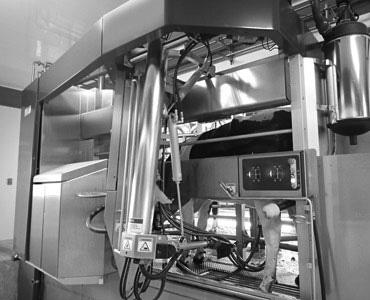

Getting into the dairy industry is difcult, particularly considering the signicant overhead required. Expanding an existing dairy can have similar challenges. There is no getting around it; buildings are expensive, especially brand-new buildings with all the bells and whistles of free stalls, sand bedding and ventilation. We often think of dairy cows as fragile, mainly because we compare them to beef cows, but they are still cows and plenty hardy enough to thrive even in a Minnesota winter.
Housing dairy cattle without a roof is a viable option for older heifers and mature cows. This can certainly work as a permanent option for housing cattle but also can help during transitional periods during expansions or startups. Severe weather conditions are certainly a concern, but with the right setup, we can keep cows healthy without a building.
To make outdoor winter housing effective, there are a few key components. A windbreak, bedding space, bunk space and water space are the most important factors.
Especially in the winter, a windbreak is one of the most important things you can provide your cattle to help them stay comfortable. Windbreaks can be naturally occurring (trees) or man-made (buildings, rows of stacked bales and other structures). The windbreak should ideally
cover the bedded pack, feeding area and watering area. Cattle will often seek out windbreaks if one isn’t provided and prioritize getting out of the wind ahead of food and water in severe winter weather.
A bedded pack provides a comfortable place for cattle to relax and ruminate. A bedded pack also keeps cattle warm and dry and should provide 100-squarefeet per cow. After a windbreak, keeping cattle dry is the next most crucial factor for successfully getting through severe winter weather. If you don’t have a bedded pack, it is benecial to provide deep bedding behind your windbreak when you know severe weather is approaching.
Adequate bunk space limits competition for resources, especially when there are mixed age groups in an area. Having sufcient bunk space will also produce a group of cattle that have a similar body condition. Having uniform body condition within a group makes nutrition decisions more applicable and makes maintaining body condition goals more achievable. Correct body condition management can result in improved performance in all aspects of a cattle operation. Provide two linear feet of bunk space per cow for the best results.



Water is often the forgotten nutrient, despite it being the most important. Proper hydration is essential for proper immune function and overall health, and water drives dry matter intake, meaning it is also the most crucial nutrient for

performance. The recommended water space is 1-2 linear inches of water space per cow. Without adequate water access, cattle will lose performance and body condition. If water is unavailable for long enough, cattle will attempt to eat snow, but they cannot consume enough snow for their water needs.
One of the most critical factors for cattle is acclimation to the weather. Cattle expected to live outside during the winter should remain outside to adjust to the changing conditions as winter approaches. This will allow the cattle to grow a thick hair coat in preparation for the cold. The hair coat needs to stay clean and dry to provide the best insulation protection for the cow.

The correct body condition for cattle will help them overwinter and help dry cows come into calving healthy. Stable body condition through the winter months will ensure cattle are best prepared to ride out severe winter weather when it happens. Uniform body condition allows targeted nutrition for the group, which is important when needing to in-


Dana Adams, adam1744@umn.edu 320-204-2968
Joe Armstrong armst225@umn.edu 612.624.3610
Luciano Caixeta lcaixeta@umn.edu 612-625-3130
Gerard Cramer gcramer@umn.edu 612-625-8184
Marcia Endres miendres@umn.edu 612-624-5391
Joleen Hadrich jhadrich@umn.edu 612-626-5620
Les Hansen hanse009@umn.edu 612-624-2277
crease the amount of feed during colder temperatures.


In extreme cold, cattle require more calories to maintain their body condition and stay warm. When the temperature approaches zero degrees Fahrenheit, you can expect to feed about 30% more than you would at temperatures above 32 degrees. Using your feed to congregate your cattle where you want them to be ahead of incoming severe weather is a great strategy. When a storm is approaching, place feed behind your windbreak to encourage your cattle to stay there.
Creek bottoms, swales and other similar landscape features can be tempting places to use as windbreaks. The problem with using these locations is that they are the prime locations for drifting snow. High winds combined with snow can create deep drifts that cause access issues for feeding cattle, water access issues and buried cattle. It is better to avoid these areas if possible and set cattle up for success in a place where heavy drifting is less likely.
Brad Heins hein0106@umn.edu 320-589-1711
Nathan Hulinsky huli0013@umn.edu 320-203-6104
Kevin Janni kjanni@umn.edu 612-625-3108
Karen Johnson ande9495@umn.edu 320-484-4334
Emily Krekelberg krek0033@umn.edu 507-280-2863
Claire LaCanne lacanne@umn.edu 507-332-6109
Brenda Miller nels4220@umn.edu 320-732-4435

Erin Royster royster@umn.edu
Isaac Salfer ijsalfer@umn.edu 320-296-1357
Jim Salfer salfe001@umn.edu 320-203-6093
Mike Schutz mschutz@umn.edu 612-624-1205
Emma Severns sever575@umn.edu 507-934-7828
Melissa Wison mlw@umn.edu 612-625-4276
Greek philosopher named Heraclitus is quoted as saying, “Change is the only constant in life.”
After working at the University of Minnesota for more than 40 years, I am wrapping up my responsibilities and cleaning out my ofce. While cleaning, I found books from ve of the dairy housing conferences organized by the American Society of Agricultural and Biological Engineers held between 1973 and 2003. The books got me thinking about changes and innovations that occurred in the dairy industry over the past 40 years.
In 1973, Paul Shea, an agricultural engineer with Minnesota Power and Light, reported that over half the new barns built in Minnesota in 1972 were tie stall. Tiestall barns were reported at the 1983 and 1994 conferences but not later conferences.
Minnesota was a hot bed of compost barn development. Minnesota’s rst compost barn was put into operation in 2001. By 2006, there were more than 30 compost barns in Minnesota. The University of Minnesota Extension dairy team hosted an international compost dairy barn conference in June 2007. Numerous research studies were conducted to better understand cow performance and pack management.
The rst cross-ventilated barn was built in North Dakota in 2005. Between September 2015 and August 2016, air temperatures and relative humidity levels were measured in a unique cross-ventilated barn in Minnesota. The unique barn was naturally ventilated in cold and mild weather and cross-ventilated in warm and hot weather. Minnesota dairy producers now use a range of barn types and innovative ventilation systems.
Total Minnesota milk production has increased from 9.6 billion pounds per year in 1970 to 10.5 billion pounds per year in 2021, even though cow numbers have declined from 949,000 to 461,000 cows over the same period (Figure 1). To accomplish that feat, milk production increased from 10,154 to 22,881 pounds per cow per year over the 51-year period.
Paul Shea also wrote about the lifting dairy farmers did for milking, feeding and manure removal in the early 1970s. I did some feed and manure lifting when I was growing up. Today, operators in milking parlors lift and attach milking equipment but do not lift the milk harvested. Milking robots can prepare cows and harvest milk without human lifting.
Dairy farms today have equipment that reduces lifting for mixing and delivering total mixed rations and handling manure. Robotic feeding systems eliminate much of the back-breaking lifting dairy farmers used to do. New and smaller sensors, cameras and more powerful electronics continue to provide dairy managers with more automation and information. Managers use the information to make operating and management decisions. Four Precision Dairy Conferences have been held in Minnesota since 2013.
Dairy producers have more ventilating options including natural ventilation, tunnel ventilation, cross ventilation and push-pull ventilation. Push-pull ventilated dairy barns have fans blowing air both into and out of barns to ventilate them. Positive pressure tube systems are an option too.
The type and size of equipment
available today provides managers with more tools to manage heat stress better. Low-pressure feedline sprinklers, highpressure misting systems, and mixing fans in barns and holding areas are tools developed over the past 40 years that help farmers manage cow heat. Numerous studies developed design and management guidelines.

Bigger, more efcient fans
Barns using tunnel, cross and pushpull ventilation rely on lots of fans. Many natural-ventilated barns have mixing fans. Most producers use larger energy efcient fans that were not available in the ‘70s and ‘80s. In the ‘80s, 36-inch diameter axial fans were some of the largest available. Now 60-inch diameter fans are available.
Lighting used in dairy barns and milking centers has changed. At the 1994 Dairy Housing Conference, R.R. Peters, an animal scientist at the University of Maryland, reviewed research on light
levels and photoperiod management for dairy cows from the mid and late 1970s. Lighting to provide 16 to 18 hours of light per day at between 10 to 30 foot-candles was reported to be paid for in two fall and winter seasons.
In the ‘90s, incandescent lights were replaced with uorescent, metal halide or high-pressure sodium xtures depending on ceiling height. Twenty foot-candles was the design minimum. Today, LED with their long life, great color rendition and energy efciency are commonly used. The LED xtures that handle damp and corrosive environments serve the lighting needs in dairy barns and milking centers well.
Dairying will continue to change and be hard work, even with the new barns, equipment and robots. More options and choices make designing and managing a dairy operation more complicated. Animal care and well-being are priorities as well as protability in a changing world. Keep up the good work. Best wishes in your future endeavors.

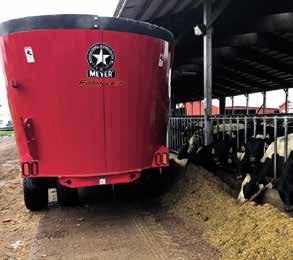

ARLINGTON, VA – First, the bad news (for consumers): Heading into the holiday baking season, butter prices are, indeed at an all-time high. That’s for a few reasons. The biggest one is simple demand. Americans love butter, with the highest per capita consumption since the 1960s leading to the highest overall demand ever for the nation’s pre-eminent spread and ubiquitous baking ingredient. Overseas markets are also getting in on the act, with another record year for dairy trade possible in 2022.
Meanwhile, butter supplies haven’t, as of yet, been able to keep up with that demand enough to stabilize prices. That’s especially been the case in the past couple months, when retailers traditionally stock up in anticipation of the holidays. And of course, once you get past the actual cost of making butter itself and then add transportation, packaging, labor, and all the other the costs that are making everything else more expensive too, you have a recipe for record butter prices on the grocery shelf. And that’s making consumers (and media) notice.
But are higher prices the same thing as a “shortage”? We posit, not. Are store shelves empty? There’s always
some one-off instances somewhere, but with those exceptions, no. Are crowds of consumers lining up for blocks outside local supermarkets to buy out rationed supplies, like early-COVID toilet paper? (Everyone stand six feet apart, please!) No again. And is anyone who wants to buy butter currently being deprived of anything other than $5 should they choose a four-pack, maybe a little extra if it’s extra-creamy European Style?!?? (And often less is you catch a good sale.)
That’s three strikes, and still, no one’s out of butter.
It’s easy to understand the concern: Butter is, after all, nature’s most perfect sandwich spread, the ingredient that makes a top-quality croissant worthy of a nasal-sounding French pronunciation. And even with all this, the underlying concern that’s fueled the “shortage” worries is itself showing signs of fading. Milk production is on the rise again, and with that, butter futures traded on commodities markets are declining. While some product prices rise and stay that way, butter goes up and down. Take a look at this chart -- a dozen years of butter-price history that includes both the value of butterfat to a farmer (blue line) and the cost at the grocery
store (orange line). See how they move together – and see where the blue line’s expected to go in 2023.
“What goes up, must come down” applies to butter. Production chases prices, and eventually higher production pushes prices down. That’s not always so great for farmers, by the way – and one nice thing for them about current pricing is that it’s helping farmers smooth out a challenging few years and rebuild the balance sheets they need to

thrive. So be patient if you’re feeling sticker shock, and in the meantime, feel good that you’re helping a farmer.


But above all, don’t feel like you’re at risk of a butterless Christmas. The food chain, and the law of supply and demand, are ensuring that doesn’t happen. The holidays would be less happy without butter, but it just ain’t gonna happen. So Happy Thanksgiving. And here’s to, um, butter days ahead.


Paynesville, MN


Fluegge’s Ag, Inc. Mora, MN



Gorter’s Clay & Dairy Equip. Pipestone, MN
Hammell Equipment Inc. Chat eld, MN

Eitzen, MN Harmony, MN Rushford, MN
Midwest Machinery Co. (Full Line) Glencoe, MN Glenwood, MN Howard Lake, MN Princeton, MN
Schlauderaff Implement Co. Litch eld, MN
Werner Implement Co., Inc. Vermillion, MN
Wingert Sales & Service Plainview, MN
How did you get into farming? I grew up on our family farm milking, driving tractor and everything else involved. Being the oldest meant I had a ton of responsibilities with the farm.
What are your thoughts and concerns about the dairy industry for the next year? I think ination and policies are some of the big concerns. The number of farms exiting the industry makes my head spin.





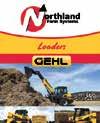




What is a recent change you made on your farm and the reason for it? We no longer breed animals to calve in December, January or February. With very little to no help, it is hard for me to get chores done and try to give calves the adequate attention they need. Plus, it is just hard calving cows in and raising calves in those months.


Tell us about a skill you possess that makes dairy farming easier for you. I am trained to do my own articial insemination. It is nice to not have to leave animals in, remember to call the breeder or have to use the bulls they sell. It is cheaper and more convenient to do it myself.



What is the best decision you have made on your farm? To become more diversied.
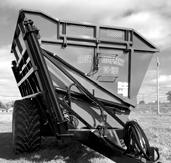


What are three things on the farm that you cannot live without? I couldn’t get by without the skid loader. We have designed the farm to make everything available to be done with the skid loader. All-terrain vehicles are also invaluable. We use them to pick rocks, haul calves, among a multitude of other things. My kids have also gotten to the point of being a ton of help and can use the ATV to do jobs for me.
What strategies do you use to withstand the volatile milk prices? We took out the highest insurance policy that was offered to help offset the volatility of the milk prices.
How do you maintain family relationships while also working together? I farm with my parents while my husband works in town. It works for us. We don't ever walk away mad or do things to upset one another.
What do you enjoy most about dairy farming? I enjoy being my own boss and having my kids with me all summer.
What advice would you give other dairy farmers? It is the hardest job you will ever have but also the most rewarding.

What are your plans for your dairy in the next year and ve years? We are planning to keep doing the same thing we are now. I have looked into doing some more no-till but haven't crossed that bridge yet.
How do you or your family like to spend time when you are not doing chores? We love going swimming, and going to my kids’ sporting events takes up all my free time year-round.



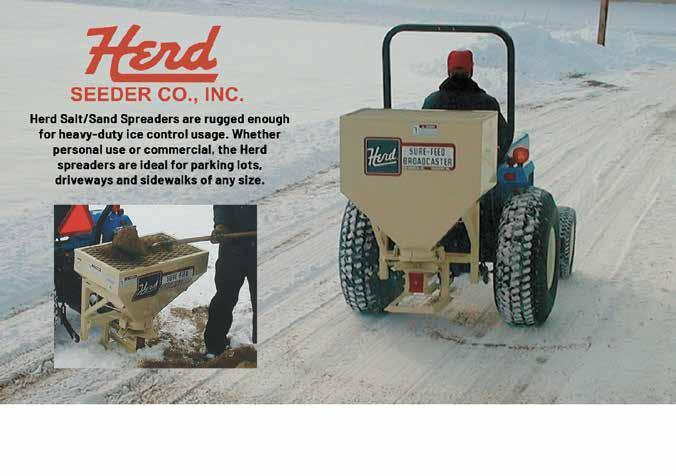



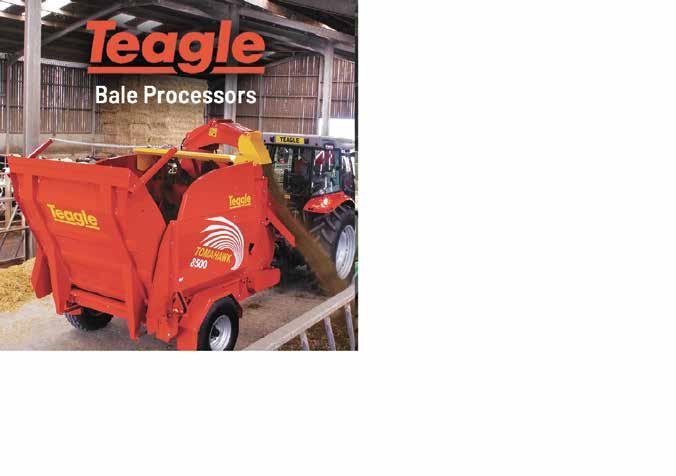
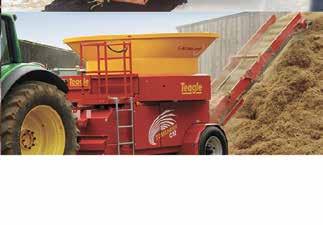



The 2022 corn silage harvest is in the rearview mirror. The dry fall provided an ideal harvest window for many growers and allowed them to achieve dry matter targets. What are our expectations of animal performance with this crop? We’ve heard reports of new corn silage feeding quite well in some areas and not so well in others. An array of factors might help explain this variation, including weather, plant genetic variation and agronomic practices such as planting dates, population, fertilization and fungicide application.
Last year’s corn silage harvest can provide perspective on some of these factors. Just over a year ago, nutritionists, dairy producers and cows were trying to gure out how newly harvested corn silage was going to feed – an annual phenomenon with incredibly important implications.
A wide range of storage options and logistics dictate when a farm will need to transition from fully fermented corn silage into silage from the new harvest season. This timeline ranges from feeding the day of harvest to several months of carryover and fermentation time. Allowing adequate storage time for wet corn is the greatest supporter of starch availability. Prolamin-zein proteins encapsulate corn starch and act as a barrier to digestion. Over time, protease enzymes (produced by proteolytic bacteria) break down this protein matrix, making starch more available. The wetter the corn source, the quicker this process occurs and the sooner the feed will reach its full starch digestibility potential.
Dairyland Laboratories Inc. recently summarized nearly 12,000 corn silage samples for the past three years across Minnesota. Results show a wide range in ber and starch content as well as ber and starch digestibility. In general, the 2021 crop was lower in starch percentage and higher in ber digestibility. Starch digestibility seemed to take longer to reach its full potential and, in most cases, never did reach levels achieved in the previous few years.
Historically, kernel maturity of approximately half milk line would correlate to about 65% wholeplant moisture. This has not been the case for many farms the past couple years. Dr. John Goeser with Rock River Laboratory Inc. has dened this change as a “moisture and kernel maturity disconnect.” Goeser said the growing season and conditions have a major impact on moisture, maturity and overall quality. He also pointed out that improved agronomic practices and healthier plants are inuential factors. Examples such as better stay-green, drought tolerance or improved fungicide application strategies are likely resulting in healthier plants and greener tissue as the kernels mature and progress toward black layer.
For many in the Midwest, the average rainfall in 2021 and 2022 were similar and decient throughout much of the growing season, but we certainly had exceptions to this trend in some areas. This is what makes it difcult to paint with a broad brush that corn silage across an entire region will perform equally.
Early indications from lab analysis show an improvement in the rate of starch digestibility in 2022 corn silage over the 2021 crop across comparable time periods. This can be seen in lab analysis with both seven-hour starch digestibility and starch Kd rate, which is a measurement of the rate of starch digestibility. Time will tell how extensively this pattern continues.
The one thing we know for certain about future corn silage harvests is they will be different from the past. It is likely we will continue to see a trend for kernel maturity to be well past half milk line at harvest with some of the agronomic practices designed to promote a healthier plant. This will require closer monitoring of whole-plant moisture at harvest along with greater emphasis on kernel processing.
Barry Visser is a nutritionist for Vita Plus.As winter starts to show its cold and windy forecasts, we start to hunker down and work as efciently as possible. We dress with layers and put on winter work jackets, Udder Tech overalls and wool socks. We make sure we have gloves in every pocket of the hooded sweatshirts and the work jackets, because they often get wet doing chores and feeding calves. If I get cold, it shortens my stamina to keep going, and I head to the house early to change socks and warm up.
As this fall was so beautiful, I was not as prepared as in the past years. November so far has been warm and sunny. Just recently, we had our rst snow that stayed on the ground. Snow makes me think of holidays. Thanksgiving is by far my favorite holiday.
and prairies. There’s a lot of farmland on I-90 through southern Minnesota and into eastern South Dakota. It does get pretty around the Badlands though, so it is worth it.
We will be driving about 10-15 hours per day. We want to see the parks along the way and hopefully be able to hike. We will have to see what the weather will give us as we head out on the road. I do know if it is snowing there will be many more hours to travel then just 30. So, with Anna holding down the farm, we will not have to worry if it is a longer stay.
We have planned on bringing some of Wisconsin’s nest cheeses and also a couple of cases of Spot-











ted Cow beer. We’ll also pack local honey and a cooler full of our processed pork, beef and venison sausage. I have pie pumpkins and apples that we will bring to make homemade pies. Both Curtis and Meeya love to cook, so they will be in charge of the turkey and all the xings. I will have to squeeze into the kitchen to make the pies while we all enjoy snacking on Wisconsin cheese and beer.
Tina Hinchley, her husband Duane and daughter Anna milk 240 registered Holsteins with robots. They also farm 2,300 acres of crops near Cambridge, Wisconsin. The Hinchleys have been hosting farm tours for over 25 years.


 By Tina Hinchley Farmer & Columnist
By Tina Hinchley Farmer & Columnist
Thanksgiving is usually celebrated with a great meal. Now as my kids have grown and moved off the farm to other parts of the country, we usually enjoy the holiday with only a few of our children. The others will get a call from us when we settle in to eat.
For us dairy farmers, it also means morning chores must get done before the turkey goes into the oven. If I am having a good night before, I can prepare the dinner rolls and pies. After morning chores, I usually head in and get stuff cooking for the big meal. This year will be completely different because Anna will be home on the farm, and Duane and I will be driving to Washington to visit our son Curtis and his wife, Meeya.
This will be the rst time Duane has visited Curtis and Meeya’s home. They moved West in 2015 after graduation. We ew out for their wedding in 2019 but were in the resort on Crystal Mountain. Then, we stayed in a house in the Mount Rainier National Park. It was such a memorable time at their wedding with all of us together off of the farm for seven days.
Curtis and Meeya have driven back to Wisconsin many times and have given us the routes and what stops they make as they travel for fuel, bathroom breaks and also for their dogs to stretch. The roads are easy. Because they are interstates, they are plowed and are open shortly after a snow storm.
Interstate 90 goes through southern Minnesota, South Dakota and Wyoming before crossing into Montana from the south. On the far western side of South Dakota, it goes through the Black Hills National Forest and the Badlands National Park. That is also fairly close to the Mount Rushmore National Memorial. When we cross into Wyoming, we will be near the Devil’s Tower National Monument and Bighorn National Forest.
I-94 goes through the Twin Cities and into North Dakota before crossing into Montana on the east. On the western side of North Dakota, you drive through Theodore Roosevelt National Park and the Dakota Prairie Grasslands. There is also a 32-mile bypass in North Dakota called the Enchanted Highway that has huge sculptures. A few are visible from I-94.
There is not a lot of difference between the two routes in terms of logistics. Both take about 30 hours total and involve about the same amount of trafc. Through the Twin Cities, I-94 can be busy if we hit it at rush hour, but it usually isn’t that bad for us otherwise. Once we are out of Minnesota, there is practically no trafc on either, and the roads run straight for miles until the mountains in western Montana.
Curtis thinks we would enjoy driving both, maybe one on the way out and one on the way back. He thinks I-94 is prettier through northern Minnesota and into North Dakota. The forest fades into the hills
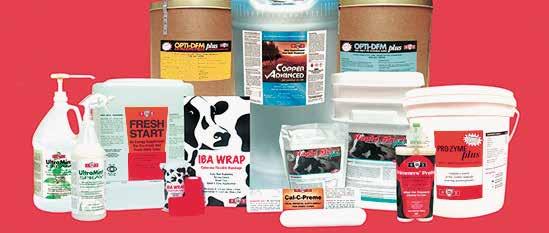
All right, someone has to say it. It’s cold.

That little nip of cold reminds us that here in the Midwest in mid-November we should be readying ourselves for the coming winter. Yet, the weather forecast tells us it will warm up again next week.
The uctuation in the temperature is making the animals and humans slightly crazy. One day it is cold enough to dig to the bottom of the winter clothes tub and search for our wool socks, thermal shirts and thick long johns; the next, I’m overdressed and sweaty by the time I make my trek to the barn. Some mornings, the cows’ breathing makes foggy clouds above the free stalls, and we have to start watching for those hidden patches of frozen manure to prevent a painful fall. Other days, the doors are ung wide to let sunshine in and curtains are rolled up. Dressing and undressing calves in their jackets is a chore t for a preschool teacher helping little ones head out to recess on a chilly day. Seeing as how we do live in Wisconsin, we should be prepared for the changing of the seasons. We sometimes have two seasons in one day. Yet, I foolishly kept hoping for a few more warm days where I would have extra hours to get some winterizing done. Now as I look outside at our snowy, slushy, slightly white world, I have to embrace the cold and put all of my warm-up strategies into effect.
There are the obvious ways to survive farming through the winter months. We are fans of Smartwool socks and insulated TideWe boots. If my feet are cold, I’m done. I can no longer think of anything else I was supposed to be accomplishing; it’s as if my brain freezes along with my toes. I carry an extra pair of thin, yet slightly warm gloves with me. It’s awfully hard to run a vaccine gun efciently with thick gloves on, so for the animals’ safety and mine, I use the thin ones. As a bonus, when I take my other gloves off, I stick them in the sleeves of my jacket, and by the time I put them back on, they are nice and toasty. We also keep a tub of mittens, scarves, gloves and a few sweatshirts in the barn for those days when anyone from kids to adults needs an extra layer to ward off the chills.
Beyond the layers of clothing, there are other, more farmer-specic ways to fend off the cold. My personal favorite way to warm up my chilled hands is to sneak them into a “cow pit,” the cow’s armpit. That is the great spot made just for hands between her front leg and body. There is also her “leg pit,” that spot between her leg and her udder. I was walking cows this morning and had to stop twice to warm up my hands. Those 1,600-pound milking machines make spectacular impromptu heaters. Dad taught us these tricks when we were little. These are tricks of the farmer trade that I have taught my children along with uttering the lines I’m certain my parents used on us: Wiggle your toes to keep them warm; jump up and down; work faster and you will warm up; and run around – that will warm you up.
Sometimes, I tell myself the house will be so nice and warm and I should appreciate the fact that I can go in there for a few hours and work in warmth. I always feel bad when the guys have to come in and warm up only to go back out in the wind and snow. To me, warming

 Ramblings from the Ridge
Ramblings from the Ridge
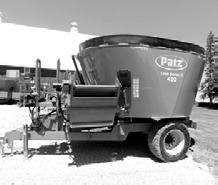 By Jacqui Davison Columnist
By Jacqui Davison Columnist
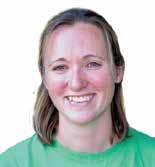

up when you have to go back out is the hardest part. It is easy to throw yourself a pity party when it comes to working outside in cold weather. Remind yourself that it could always be worse, and someone always has it worse off than you do. I may have to deal with a frozen gutter pipe and freshening cows that don’t give two hoots about the temperature, but I don’t have the wind whipping against my face as I ght with them. The voice in my head asks, “Would you rather be cooped up in an ofce?” When I answer that question, it usually freezes all of my internal griping.
There are a few other mental tricks I employ to attempt to take the chill out. When I’m cleaning the maternity pens, all I can think is what I have in the oven for lunch that will be so delicious and hot when I walk in the door. Those are the days when making lunch ahead of time pays for itself tenfold. Even better are the days when I forget that I put it in the oven by the time I make it in the basement door and the aroma surprises me. Believe me, as crazy as it sounds, I absolutely can forget about the meal I’ve prepped after a few hours in the barn. I also nd myself dreaming of how much warmer it will be when there are doors instead of my straw bale wall and an advertisement tarp blocking the wind. I nd myself thinking about how much we complain when the heat of the summer is stiing and sweat is pouring into our eyes as we throw hay bales.
At the end of the day, though, I am grateful to live in a place that sees all of the seasons in prime form even if portions of them are less desirable than others. I choose to hold onto the beauty despite the cold.
Jacqui and her family milk 800 cows and farm 1,200 acres of crops in the northeastern corner of Vernon County, Wisconsin. Her children, Ira, Dane, Henry and Cora, help her on the farm while her husband, Keith, works on a grain farm. If she’s not in the barn, she’s probably in the kitchen, trailing after little ones or sharing her passion of reading with someone. Her life is best described as organized chaos, and if it wasn’t, she’d be bored.



 By Steve Frericks Stearns County FSA executive director
By Steve Frericks Stearns County FSA executive director
Just like that, winter has arrived. Farm Service Agency staff are hopeful you were able to successfully nish harvest and get the equipment put away prior to this weather setting in.
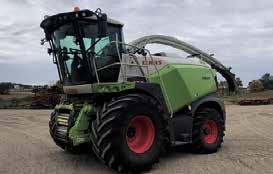
The mindset of our producers shifts to plans for the upcoming growing season. Are you looking for options to start farming or a beginning farmer looking for assistance to begin a farm operation? Are you a farmer planning to retire and looking for options to transfer the farm, or an existing farmer having nancial difculties?

It can be a challenge trying to determine where to start or how to learn about options. FSA may have a loan option to assist you. An excellent place to start is the FSA Farm Loan Discovery Tool or the Farm Loan Assistance Tool. This can be found at farmers.gov. You can also contact your local FSA ofce to review the programs or discuss any questions you may have.
Agricultural producers can now change election and enroll in the Agriculture Risk Coverage and Price Loss Coverage programs for the 2023 crop year, two key safety net programs offered by the U.S. Department of Agriculture. Producers have until March 15, 2023, to enroll in these two programs. Additionally, FSA has started issuing payments totaling more than $255 million to producers with 2021 crops that have triggered payments through ARC or PLC.
Producers can elect coverage and enroll in ARC-County or PLC, which provide crop-by-crop protection, or ARC-Individual, which protects the entire farm. Although election changes for 2023 are optional, producers must enroll through a signed contract each year. Also, if a producer has a multiyear contract on the farm and makes an election change for 2023, they must sign a new contract.
If producers do not submit their election by the
deadline, their election remains the same as their 2022 election for crops on the farm. Farm owners cannot enroll in either program unless they have a share interest in the farm.
Dairy producers can now enroll for 2023 coverage through the Dairy Margin Coverage Program, an important safety net program from the USDA that helps producers manage changes in milk and feed prices. Last year, FSA took steps to improve coverage, especially for small- and mid-sized dairies, including offering a new Supplemental DMC program and updating its feed cost formula to better address retroactive, current and future feed costs. These changes continue to support producers through this year’s signup, which ends Dec. 9.
DMC is a voluntary risk management program that offers protection to dairy producers when the difference between the all-milk price and the average feed price (the margin) falls below a certain dollar amount selected by the producer.
So far in 2022, DMC payments to more than 17,000 dairy operations have triggered for August for more than $47.9 million. According to DMC margin projections, an indemnity payment is projected for September as well. At $0.15 per hundredweight for $9.50 coverage, risk coverage through DMC is a relatively inexpensive investment.
DMC offers levels of coverage, even an option that is free to producers, aside from a $100 administrative fee. Limited resource, beginning, socially disadvantaged or veteran farmers or ranchers are exempt from paying the administrative fee, if requested. To determine the appropriate level of DMC coverage for a specic dairy operation, producers can use the online dairy decision tool.










The 2018 farm bill extends loan authority through 2023 for Marketing Assistance Loans and Loan Deciency Payments.
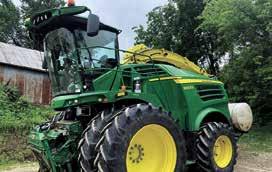



MALs and LDPs provide nancing and marketing assistance for wheat, feed grains, soybeans, other oilseeds, pulse crops, rice, peanuts, cotton,

wool and honey. MALs provide interim nancing after harvest to help meet cash ow needs without having to sell commodities when market prices are typically at harvest-time lows. A producer who is eligible to obtain a loan but agrees to forgo the loan may obtain an LDP if such a payment is available.
Contact your local ofce for rates, terms and applications. FSA is now accepting requests for 2022 MALs and LDPs for all eligible commodities after harvest. Requests for loans and LDPs shall be made on or before the nal availability date for the respective commodities.
If loan grain has been disposed of through feeding, selling or any other form of disposal without prior written authorization from the county ofce staff, it is considered unauthorized disposition. The nancial penalties for unauthorized dispositions are severe, and the producer’s name will be placed on a loan violation list for a two-year period.
Farm Service Agency is an Equal Opportunity Lender. Complaints about discrimination should be sent to: Secretary of Agriculture, Washington, D.C., 20250. Visit www.fsa.usda.gov for necessary application forms and updates on USDA programs.
Doors are opened wide as we welcome home family and friends this holiday season. It could be called an open door policy where all are welcome. That has certainly been the case around our farm these past few weeks as we welcome home family members and new friends.
It all started with an audit. Not a visit from the IRS but a third-party audit for the Farmers Assuring Responsible Management program. We were one of 11 patrons who were randomly selected to be audited. Our eld representative Nicole assured us it would be very easy. We were already used to welcoming visitors to our farm, and our FARM binder was all in order. It was just going to be a matter of checking all the boxes.
When Nicole and Colton, the auditor from Pennsylvania, arrived on Wednesday morning, it was already one of those days. The barn cleaner broke,







again. The cattle weren’t bedded or brushed off when they pulled in the yard. Nicole assured me he wouldn’t hold that against us, but he did note it on his report. Did I mention it had also rained for the past couple of days, so everything was pretty muddy? He noted that in his report too. I gured we would start the audit reviewing the youngstock, hoping to give the guys some extra time to get things done in the barn.
The audit wasn’t about numbers and nances. It was an independent audit of the protocols and practices we use on our farm to take care of our animals. The consumer is demanding assurances of good animal care in the production of their food. The FARM program was developed to meet those needs and allow us to use the best practices on our farms. I have to snicker. If we weren’t taking good care of our cattle, we would not be in business for very long. It is in everyone’s best interest to treat our cattle well.
Colton started with the calves in the domes. He popped his head in every dome to inspect each calf. He noted how well they were bedded and if they had fresh water and feed available. Good thing he came before the temperatures dropped and the water pails tend to freeze between feedings. He walked through the heifer lot looking for mobility issues and body conditions of each animal. So far so good.
By Natalie Schmitt Columnist
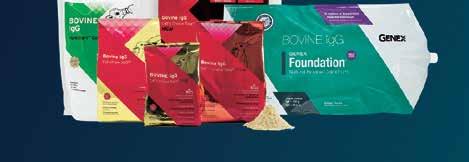

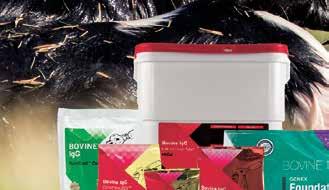

By this time, the guys were just about done cleaning and bedding the milking barn. Colton wandered up and down the main aisle and feed alleys inspecting each animal for cleanliness, body condition, broken or docked tails, bruised knees or swollen hocks. He was looking at many of the same things as a classier would but in a completely different way. It was hard to read him. I pretty much know how a classier is going to score our cows, but I had no clue how we were doing with the audit. Our animals passed with ying colors. Then, it was time for the interview.
Gathered around the kitchen island, with plates of pumpkin crunch cake and glasses of milk, we started talking. It was a very comfortable conversation and Colton seemed to relax. He was feeling right at home. After all the boxes were checked, we passed. The consumer can take comfort in knowing we are treating our animals well.
To me, it seems strange that we have to prove what we are doing. It is just common sense. We have nothing to hide. That is why we have an open door policy. All are welcome on our farm and in our home.
Our door is always open. Young friends on a long trip will make a pit-stop at our place. They know there is always a bed waiting for them. Sometimes, it is quite a surprise to discover an extra person in the house the next morning, but I’m glad they feel right at home.
Michael came home with a couple of co-workers for the last weekend of deer hunting. Guiddo is from Holland, and Mary is from Ireland. They had never hunted white tail deer and were up for a new and cold adventure. They got to the house long after we were in bed asleep and slipped out in the morning before I was up.
Once I was done with my morning chores, I headed back to the house to start making breakfast for us and our guests. Jonathon sent me a text asking if the kids could play at the farm while he and Libby went on a Christmas run. Of course. A Saturday at the farm playing with the grandchildren is a perfect day.
The hunters and the little ones all arrived at the house at the same time. It was total family chaos. Mary and Guiddo fell right into the rhythm of our crew as they became the newest members of our family. That night, we sat around the dining room table eating pizza and learning about their jobs as a reproductive physiologist and technology acquisitionist. By the end of their visit, they were homesick for their families but so glad to have a new place to call home.

As we said goodbye to all our company and family members, we reminded them of our open door policy. Just like the end of “The Beverly Hillbillies,” “Come on back now, ya’ hear.”
The door is always open.
As their four children pursue dairy careers off the family farm, Natalie and Mark are starting a new adventure of milking registered Holsteins just because they like good cows on their farm north of Rice, Minnesota.
Ten years ago, a new chapter in our dairy farming story began: switching cows through the winter. Prior to that, we had often milked more cows than the barn could hold during the summer while the herd is on pasture, but we al-
barn, I didn’t immediately understand his vision. I couldn’t see how we’d t the barn in the space he had identied, which was a small open area between our dry cow/hay shed and our manure lagoon. But I trusted that his idea would work and, boy, did it ever. We both wish we would have switched to sand ten years earlier.
Now that we’ve got a full year of sand barn use behind us, we’ve already added another row of stalls. We’re also experimenting with outside sand stalls in the courtyard between the sand barn and tiestall barn. So far, the cows seem to really like the outside stalls – at least during the day when they can bask in the sun.
By Sadie Frericks Columnist

ways downsized to t in the barn for the winter.
For many dairy farmers who milk in tiestall barns, switching cows year round is a necessary evil. The extra milk in the tank is necessary, but the extra work can be evil. Over the past decade, we’ve found ways to make it less evil.




1. Gates, gates, and more gates. Gates are one of the most important components of a successful switching system. We have two sets of gates inside the barn. We use them like locks and dams to help usher cows into stalls. We also use portable corral gates to divide our cow yard into two sections. The inside cows go in one section while the outside cows come in for milking. (We use these sections for dividing the herd into milking groups during the summer, too.)
We only have one hard and fast rule for switching cows: Don’t mix the groups! Gates make following that rule a whole lot easier.
2. Switch cows around. For the most part, during the winter our inside cows are rst lactation Holsteins and Jerseys; our outside cows are older, larger Holsteins. But if a particular cow doesn’t do well in the inside group, we move her to the outside group. Conversely, we had one outside cow last winter who decided that laying half in and half out of a sand stall was more comfortable than laying properly in the stall; she quickly became an inside cow.







3. Housing makes a huge difference. For nine winters, our outside cows rested on an outdoor bedded pack. Last winter we moved them into sand-bedded freestalls. The difference between a bedded pack and sand stalls is night and day. Our cows are now cleaner, they milk more, and prep time during milking is a fraction of what it used to be.




To be honest, when Glen rst suggested building a sand-bedded freestall

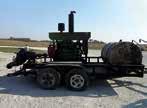



4. Milking order matters. For the past ten winters, we milked the inside cows rst, switched the groups, milked the outside cows, and then brought the inside cows back in. Two weeks ago, after morning milking, when the cows decided the weather was too nasty to go out to pasture, we let the rst group into the sand barn and kept the second group in the barn for the day. When evening milking came around, it didn’t make sense to milk the second group rst, so we let them out and brought the rst group in. And, then, we just kept that milking order: let the inside cows out, milk the outside cows rst, switch the groups, and milk the inside cows last.
What we discovered after a couple days is that this milking order is way better than the order we used to follow. The time required for milking and switching is about the same, but the psychology is a lot better with the new way. In the past, we’d get done milking and then still have to let the outside cows out, clean stalls, re-bed, and bring the inside cows back in. Now, since all of that is done before and during milking, when we get done milking, we can shut the lights off and go to the house.
If there’s one lesson we’ve learned well in our years of dairy farming, it’s to always be open to change. Don’t keep doing things one way because that’s the way you’ve always done it. Even when you think something is going well, there’s almost always a way to do it better.
Switching from the pack to sand stalls was a big decision with a huge impact. Switching our milking order was a small change – that was hardly a conscious decision at all – with an outsized impact. Both changes denitely made switching cows better. We could have easily missed these opportunities for improvement if we hadn’t been open to switching things up.
Sadie and her husband, Glen, milk 100 cows near Melrose, Minnesota. They have three children – Dan, Monika, and Daphne. Sadie also writes a blog at www. dairygoodlife.com. She can be reached at sadiefrericks@gmail.com









